|
Best of Me Sahyadri NATURE 2016 |
|
December 2016- B |
|
Volume 3, number 20 |
|
|
Please use minimum 1280 pixel horizontal screen resolution for viewing. Please be patient while all the images in webpage are loaded. Please do not use the images for any commercial use without permission. Text in Marathi and English is not exact translation. Please give sufficient time to allow the photographs to load. Special thanks to all who helped me during the photography sessions and compilation activity. |
|
|
|
|
देशाची आर्थिक प्रगती व्हावी असे सर्व नागरिकांना वाटणे सहाजिक आहे. अर्थकारणामुळे मिळणारा रोजगार, समृद्धी यासाठी सर्वांनाच आर्थिक प्रगती हवी हवीशी वाटते. आर्थिक प्रगती होताना, त्याचा दिर्घकाळात समाजावर, निसर्गावर, वातावरणावर दुष्परिणाम होणार नाही याची काळजी घेणे महत्वाचे आहे. मनुष्याच्या भावी पिढ्यांना पाणी, शुद्ध हवा, योग्य वातावरण मिळत रहावे अशी भावना मनात रुजणे महत्वाचे आहे. वाढत्या आर्थिक प्रगतीमुळे नैसर्गिक संपदेवर ताण येतो. प्रगतीसाठी प्रदुषण होते. जंगले, माळराने, व इतर अधिवास नष्ट होतात. वसुंधरेवर रहाणाऱ्या इतर जीवांचा मात्र मनुष्य फारसा विचार करत नाही. आर्थिक प्रगती करताना, मनुष्य निसर्गाची हानी करत आहे. मुळताच माणसाला निसर्गाचे महत्व समजणे हे सध्याच्या आपल्या प्रगत जीवनशैली मुळे अवघड झाले आहे. आर्थिक प्रगती, समाजाची प्रगती व निसर्ग संपदेची निगा, यांचा समतोल राखणे काळाची गरज आहे.
सह्याद्री (पश्चिम घाट) हा एक नैसर्गिक संपदेचा, वैविध्यतेचा, भौगोलिक व ऐतिहासिक ठेवा आहे. वाढत्या मानवी अतिक्रमणाचा, सह्याद्रीच्या विविध घटकांवर होणारा दुष्परिणाम भविष्यात आपल्यालाच धोका निर्माण करेल, यात शंका नाही. शुद्ध पाणी, हवा व उर्जा, भावी पिढीला मिळण्यासाठी, नंद्यांचे उगम असलेला सह्याद्री व त्याभागातील जंगले टिकवणे महत्वाचे आहे. सह्याद्रीच्या महत्वाच्या घटकांचे महत्व छायाचित्रांद्वारे प्रकट करण्याचा मी येथे प्रयत्न केला आहे. येथील पक्षी, प्राणी, वनस्पती, अधिवास, किल्ले व लेणी अशा विविध विषयांबद्दल आपण समजुन घेऊ.
|
|
As the economic development has taken the center stage, the balance between the environmental sustenance and socio economic development will be under the scanner. As most experts with balanced views have proclaimed, Indian wildlife and ecological system sustenance will be under threat, unless precautions are taken with the help of appropriate research and long term national interests. As we encounter the economic development, many habitats which indirectly or directly help sustainable development will be damaged. The awareness to gauge the success by sustainable development and not by year to year growth is a distant dream any environmentalist will assume in current scenario.
Western ghats, or Sahyadri as we all call it as, is a treasure trove of spectacular landscapes, biodiversity, flora, fauna, some amazing geological wonders and man made monuments. With the increasing pressure from human encroachment, all these elements are under stress and in turn are under depletion. Western ghats should be left untouched by human beings, to protect their future generations from getting short of resources, such as water, energy and clean air. The important elements of western ghats, which need protection are highlighted in the new version of Photo journal, Me Sahyadri Magazine. The current issue has few of the the best photographs taken by me from the Western Ghats in 2016.
|
|
|
| |
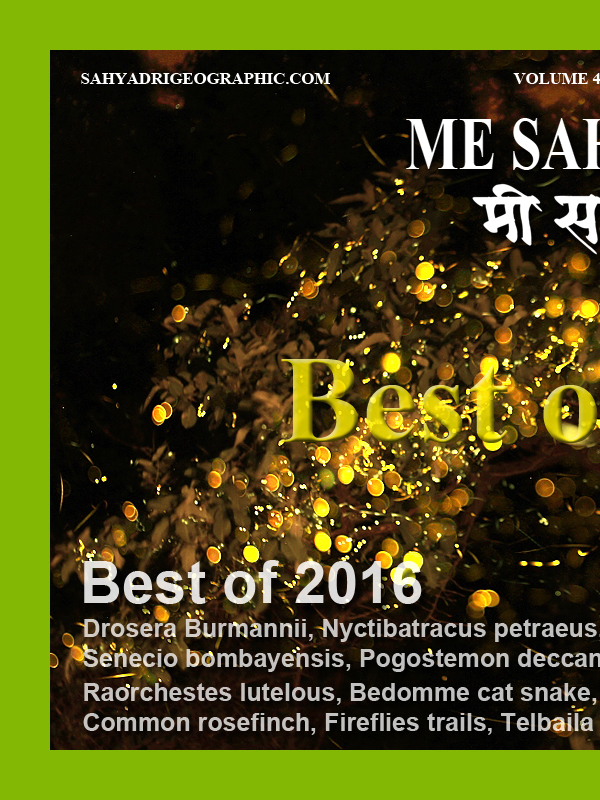 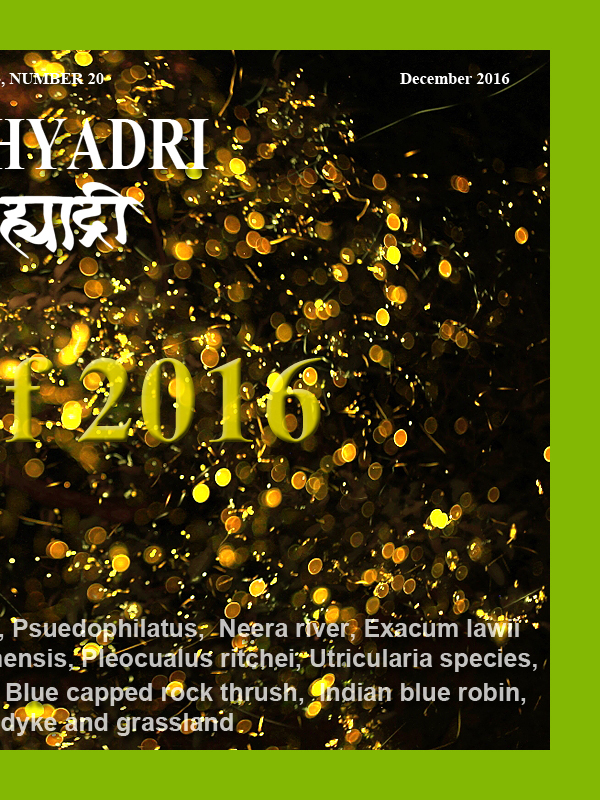
|
| |
| Me Sahyadri – Best of 2016
|
| |
|
|
| |
  |
| The banner has been published here to improve the awareness of the trekkers and tourists visiting the various mountain forts, mountains in north western ghats. Please avoid accidents, by following good outdoor ethics such as no swimming in cisterns at mountain forts, no rock climbing without proper technical equipment and expertise. Please do not adventure, trek with any group or individually without understanding the risks associated. The frequency of the solo trekker fatalities have increased recently. Please strictly avoid solo treks. Please also avoid treks to mountains in large commercial groups, as it leads to damage to biodiversity of these high elevation ecological islands. Please respect the wildlife and biodiversity of the region. This has become more important as the ever increasing human interference is leading to severe damage to fragile ecosystems. Please be aware of the wildlife and biodiversity of the mountains before visiting these mountains. Please follow outdoor ethics. Follow ASI and Forest department rules. The concept of use of symbols for outdoor ethics was conceived and designed by "Sahyadri Trekker Bloggers Group". |
| |
|
|
| |
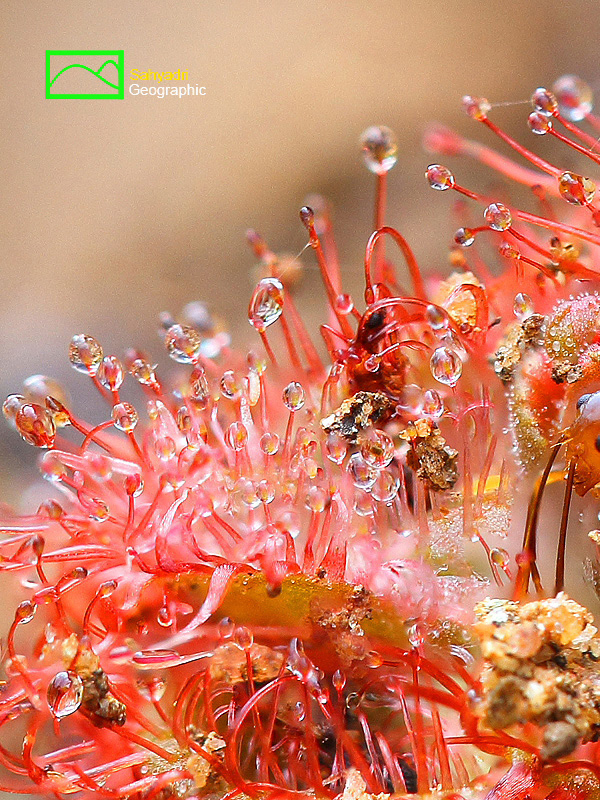 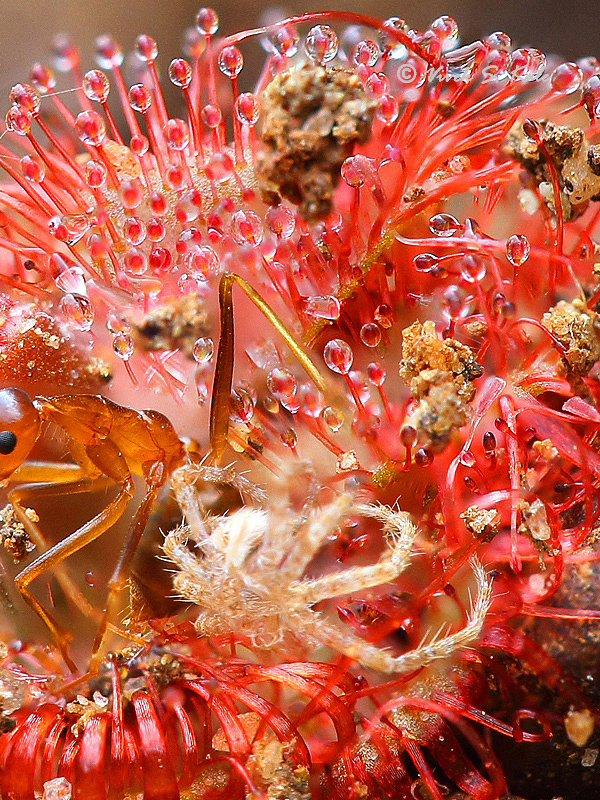 |
| 1. Drosera Burmannii, Uttar Kannada district, Karnataka, Western ghats, India |
| |
|
|
समजा आपण एक उडणारा छोटा किडा आहोत. गवताच्या गालिच्यावरुन भरारी मारत फुलांमधील रस गोळा करत उडताना अचानक, तुम्हाला आकर्षक चकाकणारे मध, द्रुष्टित येते. मध आकर्षक मध चव घेण्यास खुणावते. अत्यानंदाने तुम्ही त्या दिशेने झेपावता. जवळ जाताच मन्त्रमुग्ध करणारा सुगन्ध तुम्हास बेहोश करतो. स्वर्गच जणु. एवढे दिवस आपणास हा स्वर्ग का सापडला नाही ? असा एक खुळा प्रश्न पडतो. मोह न आवरता तुम्ही त्या मधुकणांवर उतरता. मध चवीष्ट वाटते. घट्ट चिकट मधात तुमचा एक पाय अडकतो. पाय ओढता ओढता, दुसरा पाय चिकटतो. काही कळण्याच्या आतच, तिसरा व चौथा पाय अडकतो. गोड मधात उगाच उतरलो असे वाटू लागते. जीवाची कासावीस सुरु होते. धडपडीत पंखसुद्धा मधात फसतात. थोड्या वेळात वनस्पती तुम्हाला घेरते. अंगात जळजळ सुरु होते. जीवंत रहाण्याची आशा मावळते. तुम्ही जर नशिबवान असाल तर गुदमरुन लवकर मराल पण नसाल तर ताटकळत वेदना सहन करत मराल. हि आहे घातक दवबिंदू वनस्पतीची मायावी दुनिया. वरिल घटनाक्रम एखाद्या किड्या मुंग्यांच्या भयाणपटातील आहे असे वाटत असले तरी हि सत्यपरिस्थिती आहे.
|
|
Drosera burmannii ( दवबिंदूं ) is a small tropical sundew. It was first described by Johannes Burman 18th Century botanist, but the species was not formally published until 1794 when Martin Vahl named it in honor of Burman as Drosera burmanni. It is one of the compact species in the carnivorous plant genus Drosera of size, only 20-25 mm in diameter (roughly of the size of one Indian rupee coin). Drosera burmannii ( दवबिंदूं )traps the insects very fast and its leaves can curl around the prey insect in few seconds, compared to the minutes or hours it takes other sundews to trap the prey. Drosera burmannii is an herb that produces short stems and leaves in a rosette. (a rosette is a circular arrangement of leaves, with all the leaves at a particular height.) Tiny creamy white flowers are produced in groups on 6–15 cm tall racemose inflorescences, (An inflorescence is a group or cluster of flowers arranged on a stem that is composed of a main branch.).
|
|
|
| |
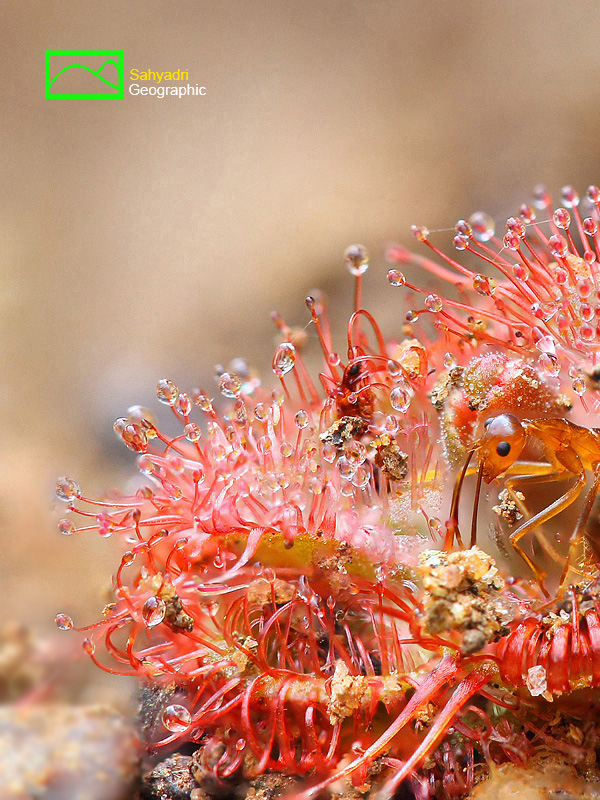 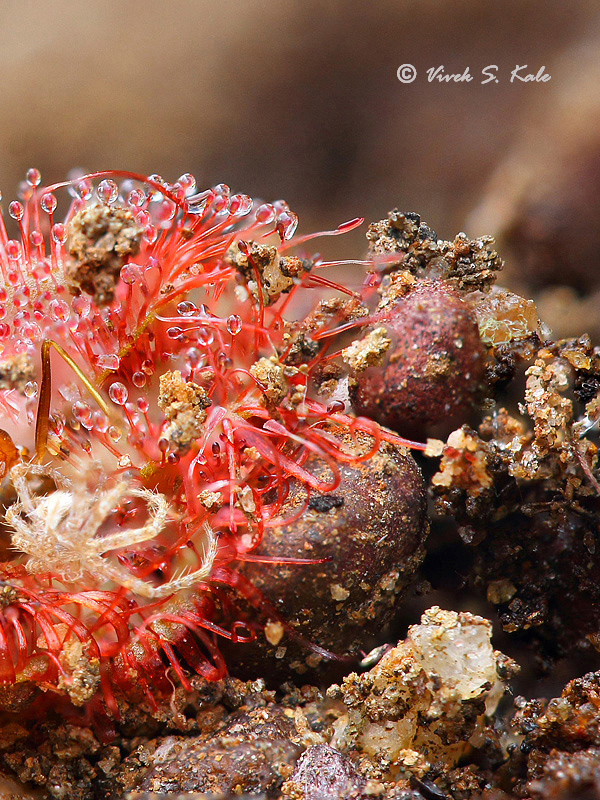 |
| 2. Drosera Burmannii, Uttar Kannada district, Karnataka, Western ghats, India |
| |
|
|
The plant flowers in September to December duration. The plant has long tentacles on its leaves. These stalks are tipped with glands which are often brightly attractive red colored. The glands exude attractive nectar, adhesive compounds, and digestive enzymes. Insects that land on the leaves stick fast and are digested. Nearby glandular tentacles are stimulated and also adhere to the insect, the entire leaf coils around the prey. The tentacles can bend in any direction. But when a prey is caught on a leaf, all the tentacles know the direction to bend towards. In Drosera burmannii, the tentacle motion is faster. Some of the glands can bend 180 degree in just tens of seconds. The 'nectar' on the end of the glands is sticky liquid glue which is capable of ensnaring an insect larger than the leaf itself. Once prey becomes stuck on one of these blobs of glue, any frantic struggling will simply cause it to come into further contact with neighboring glands, pinning the animal to the leaf. The plant has retaining glands which fold from the outside of the leaf in towards the centre to help to restrain the insect.
|
|
The leaf itself curls around the victim, thus ensuring a meal. For most insects, death is caused by suffocation since the breathing holes on the side of the insect soon become clogged with mucilage. Once prey is pinned down, the leaf secretes digestive fluids from sessile glands along the body of the leaf. These work on reducing the fleshy internal part of the insect into a nutrient soup which is subsequently absorbed by the plant. Once digestion and absorption is complete, the leaf returns to its ready state, leaving to dried exoskeleton to be washed away by rainfall, or simply left as a macabre warning to other insects.Drosera burmannii cannot obtain nitrates from soil due to the absence of nitrate reeducates and other essential enzymes for absorbing them.It obtains nutrients solely from the capture of prey insects. Basically when it comes to carnivorous plants, the lower the quantity of soil nutrients and the higher the quotient of sunlight and rainfall, the greater their reliance on carnivory. Accordingly most carnivorous plants grow where sunlight and water are plentiful and nutrients such as nitrates and phosphates are low.
|
|
|
| |
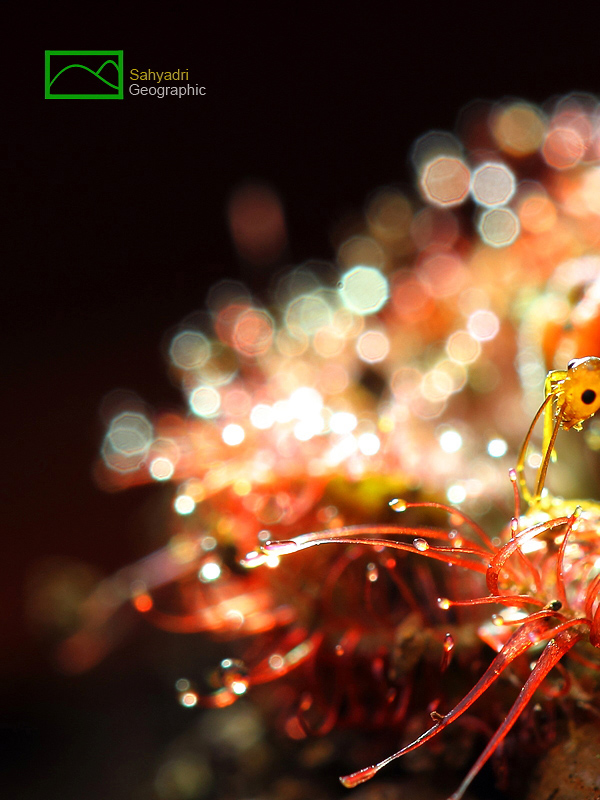  |
| 3. Drosera Burmannii, Uttar Kannada district, Karnataka, Western ghats, India |
| |
|
|
| |
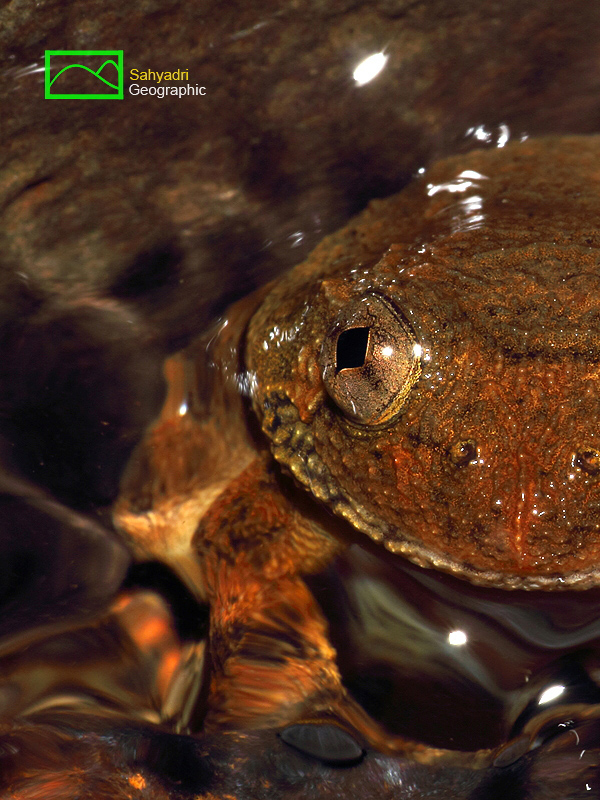 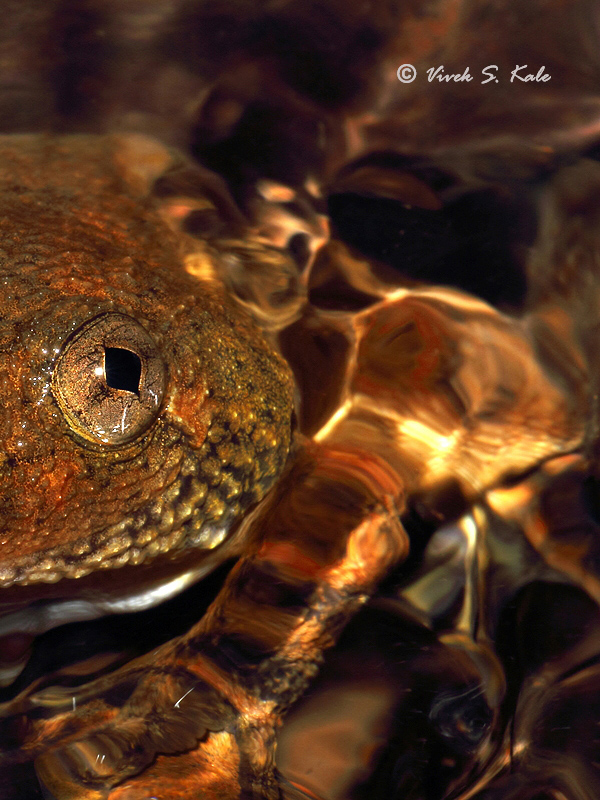  |
| 4. Nyctibatracus petraeus, Castle rock night frog, Sindhudurg district, Maharashtra, Western ghats, India |
| |
|
|
बेडकांबद्दल महत्वाच्या १० बाबी,
१) बेडुक पाण्याजवळ किंवा पाण्यात रहातात. ते प्रदुषणाचे निर्देशक आहेत. जलप्रदुषणामुळे बेडुकांची संख्या कमी होते आहे. शेतात वापरल्या जाणाऱ्या किटकनाशकांमुळे व इतर रसायनांमुळे जलप्रदुषण होते.
२) बेडकांचे लहान अधिवास मोठया जंगलाच्या अधिवासाचे लहान भाग असतात. झाडे, तलाव, डबकी, झुडुपे, झरे व ओढे, दगड धोंडे असे विविध अधिवास विविध बेडकांना आश्रय देतात. या सर्व घटकांचे संवर्धन म्हणजेच बेडकांचे संवर्धन होय.
३) पश्चिम घाटात दिसणारे बहुतांश बेडुक अंतर्जन्य आहेत. त्यांचा अधिवास पश्चिम घाटापुरता मर्यादीत आहे. पश्चिम घाटाचे संवर्धन म्हणजे त्यांचे संवर्धन होय.
४) जलप्रदुषण, शेतकी प्रगती, बुरशी रोगराई, अधिवासाचा विनाश अशा कारणांमुळे बेडुक कमी होत आहेत.
५)बेडुक हा खाद्यश्रुंखलेतला महत्वाचा घटक आहे. लहान किडे, डास यांना खाद्य करुन तो त्यांच्या संख्येवत नियंत्रण ठेवतो.
६) बेडुक पावसाळ्या व्यतिरिक्त काळात सुप्त (हायबरनेट) होतात.
७) बेडुक पावसाळ्यात अंडी टाकतात.
८) सह्याद्रीत आढळणाऱ्या बेडकांमध्ये बरेच बेडुक संकटात आहेत. आय यु सि एन संस्थेच्या वर्गिकरणाप्रमाणे या बेडकांना वाचवण्याचे प्रयत्न झाले पाहिजेत.
९) वाघ, सिंहांवर जेवढे पैसे खर्च केले जात आहेत, त्यामानाने बेडकासारख्या लहान पण तितक्याच मह्त्वाच्या प्राण्यांकडे सर्वच दुर्लक्ष करत आहेत.
१०) पश्चिम घाटात सध्या काही नविन बेडकांचे शोध लागले आहेत. बऱ्याच जातींवर संशोधन चालु आहे.
पश्चिम घाटामध्ये, महाराष्ट्राच्या दक्षिण भागात सिंधुदुर्ग जिल्ह्यात, बेडकांचे विविध लघु अधिवास आहेत. गवताळ डोंगर, सदाहरित जंगल, लहान झुडपे, पाणथळ डबकी, झरे, असे अनेक लहान अधिवास असल्याने येथे बेडकांच्या विविध जाती आढळतात. या बेडकांमध्ये निक्टिबॅट्रचस जातीचे पाण्यांच्या प्रवाहाजवळ दगडावर रहाणारे बेडुक सुद्धा आहेत. सतत होणाऱ्या जंगलतोडी मुळे या फ्रॉग्स ची संख्या कमी होत आहे. जंगलतोड करुन विस्तारली गेलेली शेती व अनियंत्रित पर्यटन त्यांच्या ऱ्हासाची प्रमुख कारणे आहेत.
या विविध फ्रॉग्स मध्ये निक्टिबॅट्रचस पेट्रायस नावाचा एक मध्यम आकाराचा बेडुक आहे. हा बेडुक मध्यम पानगळीच्या किंवा सदाहरित दमट जंगलात, पाण्याच्या ओढ्यांलगत आढळतो. हा बेडुक निशाचर आहे. याला अंबोली निशाचर बेडुक असे म्हणतात. त्याचे प्रजनन जंगलात ओढ्यांजवळ होते. त्याच्या अंगावर सुरकुत्या असतात. त्याच्या डोळ्यांमधले बुबुळ चौकोनी असते. हा बेडुक सह्याद्रीत अंतर्जन्य (एन्डेमिक) आहे.
|
|
10 important aspects about frog are
1) Frogs are indicators of water pollution. The population of frogs is reducing due to water pollution. Water pollution takes place due to use of pesticides and other chemicals.
2) Frogs live in microhabitats within the larger forest habitat. These microhabitats can be streams, rocks, trees, bush, puddles, soil, low foliage. Conservation of every such element within the larger forest habitat is important.
3) Western ghats has many endemic species of frogs.Conservation of western ghats is important for survival of these species.
4) Water pollution, agricultural development, tourism, fungal infections, loss of habitat are the main reasons of reduction in numbers of frogs.
5) Frog is important part of food chain. They feed on insects, mosquitoes.
6) Frogs hibernate most of the time in year during non monsoon period.
7) Most of the frogs in western ghats breed in Monsoon.
8) Many species of frogs in western ghat appear as Threatened as per IUCN red list. The species are protected as per Indian Wildlife act.
9) Govt is spending funds on tigers and lions but not on frogs.
10) Many species of frogs in western ghats are being discovered. The research on the frogs is under progress by various research organizations.
The western ghats in Amboli region in Maharashtra state has a wide array of microhabitats for the frogs. The streams, water puddles, lateritic rocks and plateaus and moist evergreen forest are few of the arrays of microhabitats in the region. Both rocky plateaus and evergreen forests in western ghats have seasonal water streams during the monsoon season. Nyctibatrachus frogs are seen around the water streams in evergreen forests. These are nocturnal species mainly active in the night.
One of the Nyctibatrachus frogs of the region is Nyctibatrachus petraeus, commonly known as Amboli night frog. Nyctibatrachus petraeus is recorded in torrential freshwater streams in evergreen and moist deciduous forest. Breeding takes place in streams in the forest. It is not seen in degraded forests. It is endemic to western ghat, and is rated as Least concern as per IUCN red list. The frog is gray brownish in color with wrinkled texture on its skin. The front leg and hind leg digits have discs which help the frog to climb the rocks. It lays the eggs on rocks and guards the eggs from predators.
|
|
|
| |
   |
| 5. Psuedophilatus species, Sindhudurg district, Maharashtra, Western ghats, India |
| |
|
|
पश्चिम घाटामध्ये महाराष्ट्राच्या दक्षिण भागात, अंबोली च्या जवळ , बेडकांचे विविध लघु अधिवास आहेत. गवताळ डोंगर, सदाहरित जंगल, लहान झुडपे, पाणथळ डबकी, झरे, माणसाने लावलेली लागवड असे अनेक लहान मोठे अधिवास असल्याने येथे बेडकांच्या विविध जाती आढळतात. या बेडकांमध्ये बुश फ्रॉग म्हणजे झुडुपांमध्ये व लहान झाडांवर रहाणारे बेडुक सुद्धा आहेत. सतत होणाऱ्या जंगलतोडी मुळे या बुश फ्रॉग्स ची संख्या कमी होत आहे. जंगलतोड करुन विस्तारली गेलेली शेती व अनियंत्रित पर्यटन त्यांच्या ऱ्हासाची प्रमुख कारणे आहेत. या विविध बुश फ्रॉग्स मध्ये प्स्युडोफिलॅटस अंबोली नावाचा एक मध्यम आकाराचा बेडुक आहे.
हा बेडुक मध्यम पानगळीच्या किंवा सदाहरित जंगलात व त्याच्या आजुबाजुस आढळतो. महाराष्ट्र (दक्षिण) राज्यात सह्याद्रीत समुद्रसपाटीपासुन ७५० मीटर उंचीवर असलेल्या जंगलात तो आढळतो. आय यु सि एन संस्थेच्या वर्गीकरणात या बेडकास "क्रिटिकली एन्डेन्जर्ड" असा वर्ग देण्यात आला आहे. या बेडकांचा अजुन खुप अभ्यास होणे अपेक्षित आहे. या बेडकाचे वैशिष्ट्य म्हणजे तो झाडावर रहातो. त्याच्या पुढच्या व मागच्या पायांना बोटांच्या टोकांना लहान तबकड़्या असतात. या तबकड़्यांचा वापर बेडुक झाडांवर चढण्यास करतो. नराला मानेजवळ एक फुगा असतो. सुर्यास्तानंतर तो फुगा फुगवुन मादीला आकर्षित करण्याचा प्रयत्न करताना दिसतो.
|
|
The western ghat in Amboli region in Sindhudurg district of Maharashtra haswide array of microhabitats for the frogs. Psuedophilatus frog genus is under grave threats, mainly due to the habitat degradation caused by the deforestation, agricultural practices and unplanned tourism. One of the bush frogs of the region is Psuedophilatus amboli, commonly known as Amboli bush frog. This frog is seen in evergreen shrubs and forest trees in moist semideciduous forests.
It is endemic to western ghats, and is rated as critically endangered as per IUCN red list. The frog is seen mainly in north western ghats around Amboli village. The altitudinal range of this species is 700-800 meter above sea level. The front leg and hing leg digits have discs which help the frog to climb the bushes and small rocks. The front legs do not have any webs. Males have a median vocal sac. This species begins calling during or immediately after sunset.
|
|
|
| |
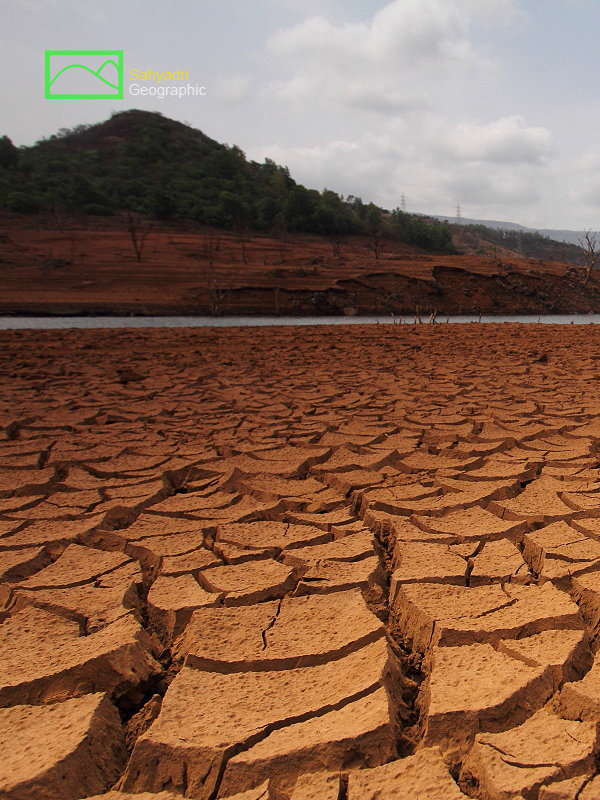 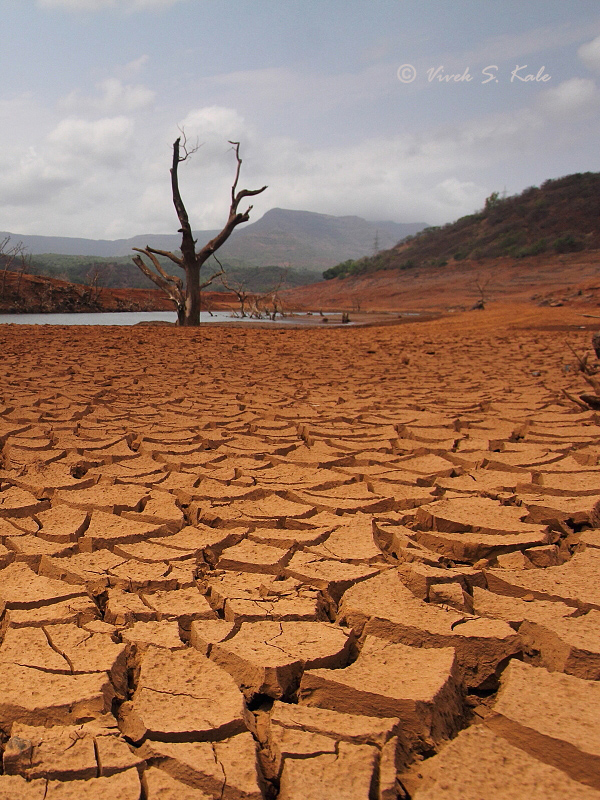  |
| 6. Neera river (Premonsoon-post El nino draught, May 2016) , Pune district, Maharashtra, Western ghats, India |
| |
|
|
निरा नदी पुणे जिल्ह्यातील एक महत्वाची नदी आहे. नदीचा उगम जिल्ह्याच्या दक्षिण पश्चिम रायरेश्वर डोंगराच्या उत्तर भागात होतो. नदी पश्चिमेकडुन पुर्वेस वाहते. भाटघरच्या पुर्वेस नदी पुणे व सातारा जिल्हाची सीमा आहे. उगमापासुन अंदाजे ७५ कि मी अंतरावर नदी सोलापुर जिल्ह्यात भीमा नदीस जाउन मिळते. येळवंडी, गुंजवणी व कऱ्हा या निरेच्या उपनदया आहेत. पर्जन्यछायेच्या शुष्क प्रदेशातुन हि नदी जात असल्याने या नदीचे महत्व अनमोल आहे. उगमाजवळ या नदीवर निरा देवघर धरण आहे. वाटेत वीर येथे उथळ धरण आहे. येळवंडीवर भाटघर, व गुंजवणीवर वेल्हे येथे धरण आहे. हिवाळ्यात या नदीवर बार हेडेड गिज सारखे स्थलांतर करुन येणारे पक्षी लडाख व मध्य आशिया खंडातुन येतात.
|
|
Nira is one of the important river which originates in the western ghat hills in south west of Pune district. The river originates in the Raireshwar hills and eventually meets Bhima river near Akluj in Solapur district. The river traverses through a highland in rain shadow region and plays important role in irrigation of the dry and arid region. The river forms the border of Pune and Satara district east of Bhor and has important water reservoirs at Neera Deoghar at origin and Veer on the way. The river has important tributaries such as Yelwandi, Gunjawani and Karha. The Yelwandi river has its own reservoir known as Bhatghar. The Gunjavani has its own reservoir at Velhe. Karha has its own reservoir near Jejuri. The river travels from west to east for about 75 km to meet Bhima river. Large number of population depends on this river, making it one of the most worshipped rivers of the region. The river also supports the important migratory birds such as bar headed geese, from Ladakh and Central asia every winter.
|
|
|
| |
 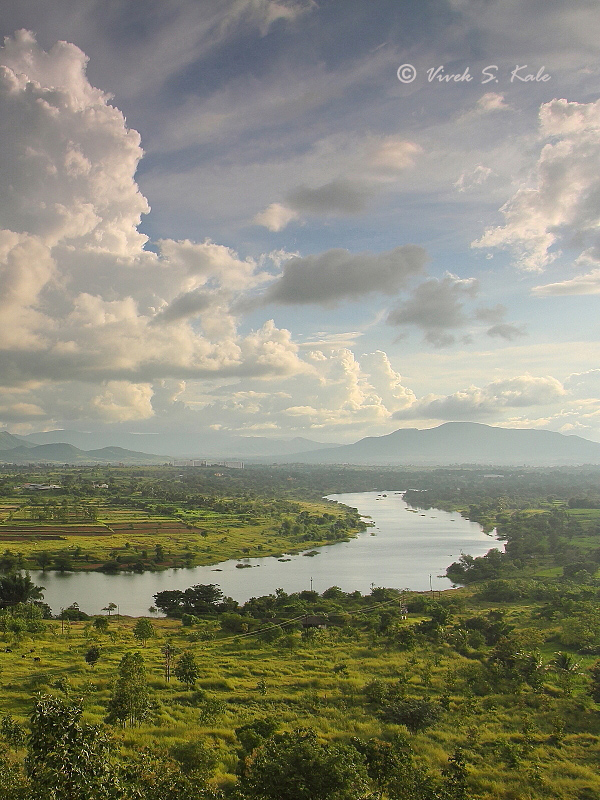
|
| |
| 7. Neera river (Postmonsoon, Sept 2016), Pune district, Maharashtra, Western ghats, India |
| |
|
|
| |
 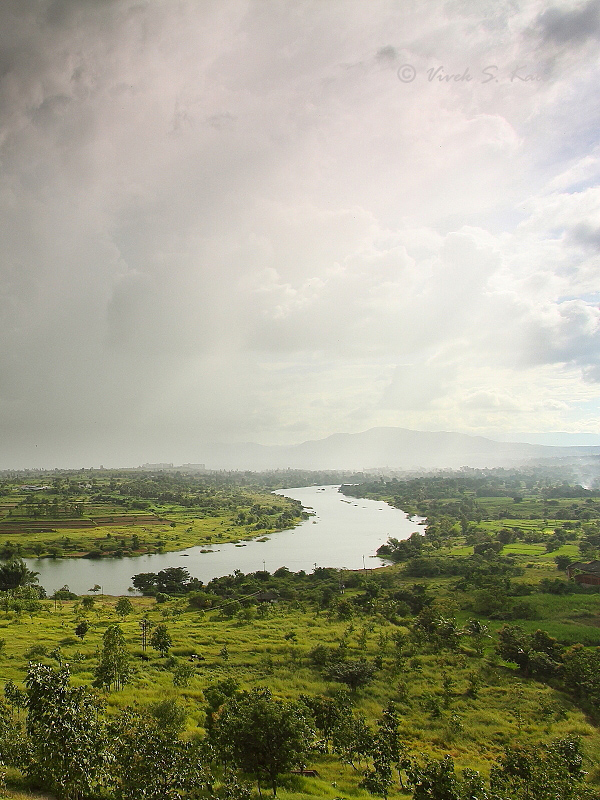
|
| |
| 8. Neera river (Postmonsoon, Sept 2016), Pune district, Maharashtra, Western ghats, India |
| |
|
|
| |
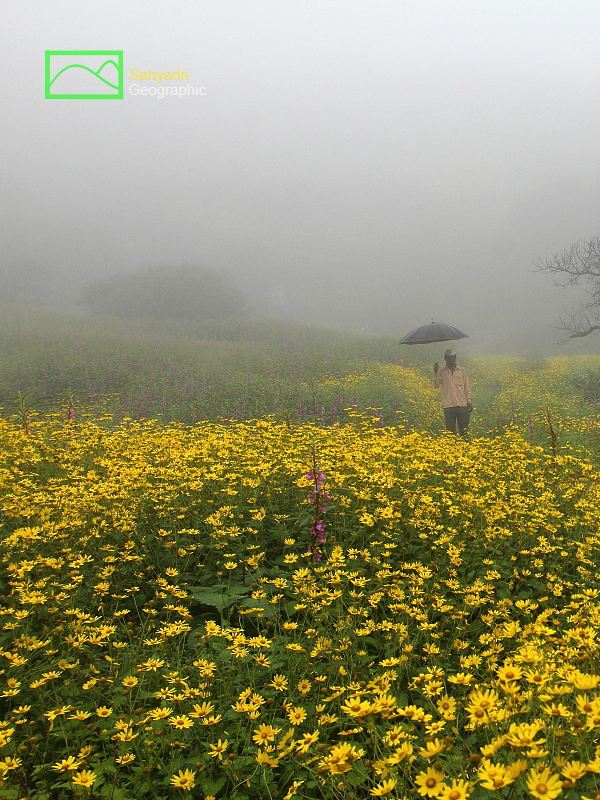 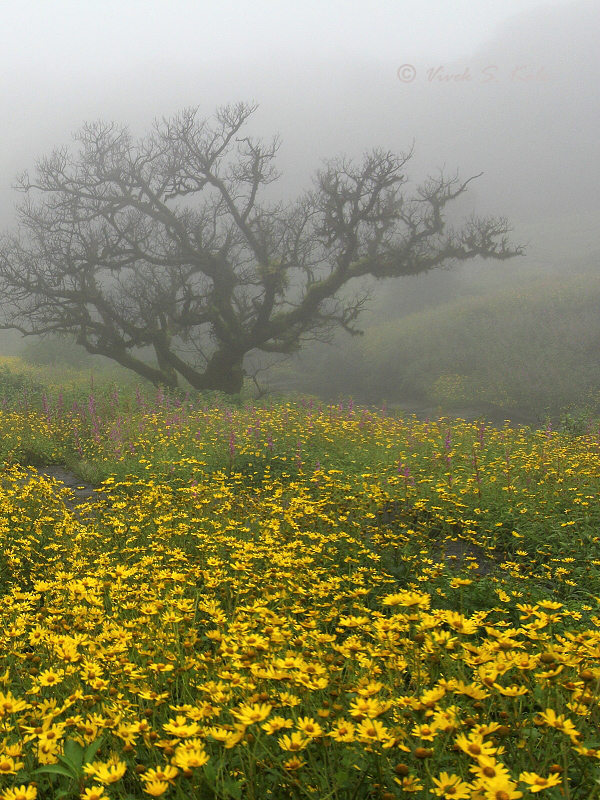
|
| |
| 9. Senecio bombayensis mass bloom, Ahmednagar district, Maharashtra, Western ghats, India |
| |
|
|
पावसाळ्याच्या उत्तरार्धात सोनकीची सोनेरी फुले घाटमाथ्यावर सह्याद्रीत सर्वदुर फुलतात. डोंगर उतारावर, घरांच्या छपरावर, कड़्याच्या टोकावर सर्वत्र सोनकीची फुले दिसतात. या फुलांची मधली तबकडी पिवळसर सोनेरी असते व याला १० ते १५ पाकळ्या असतात. शास्त्रीय भाषेत या वनस्पतीला सेनेसिओ बॉम्बेन्सीस असे म्हणतात.
.
|
|
Senecio bombayensis is called as Sonki in Marathi. It is a gregarious plant of western ghats which mass flowers in later period of monsoon season in September. It is seen on hill slopes on north western ghats and is endemic species. The flowers are golden yellow with 10 to 15 petals, with a dark golden yellow disks.
|
|
|
| |
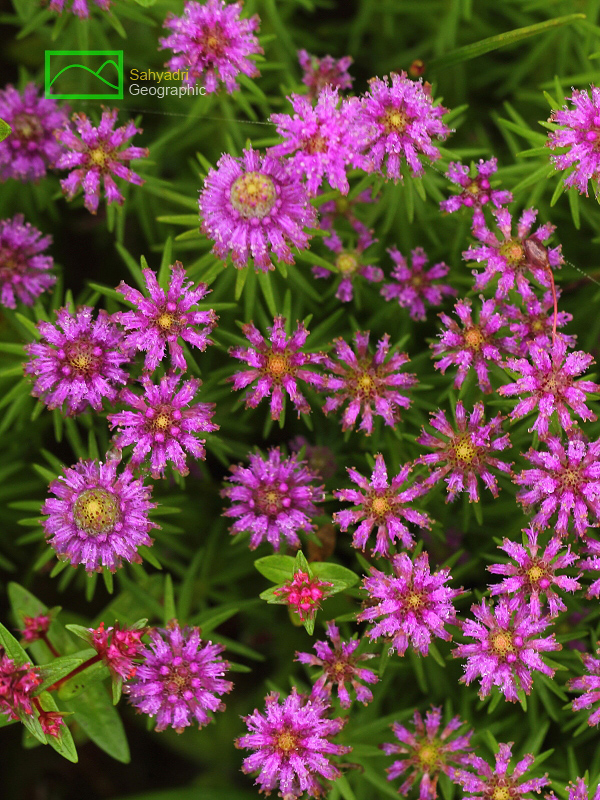 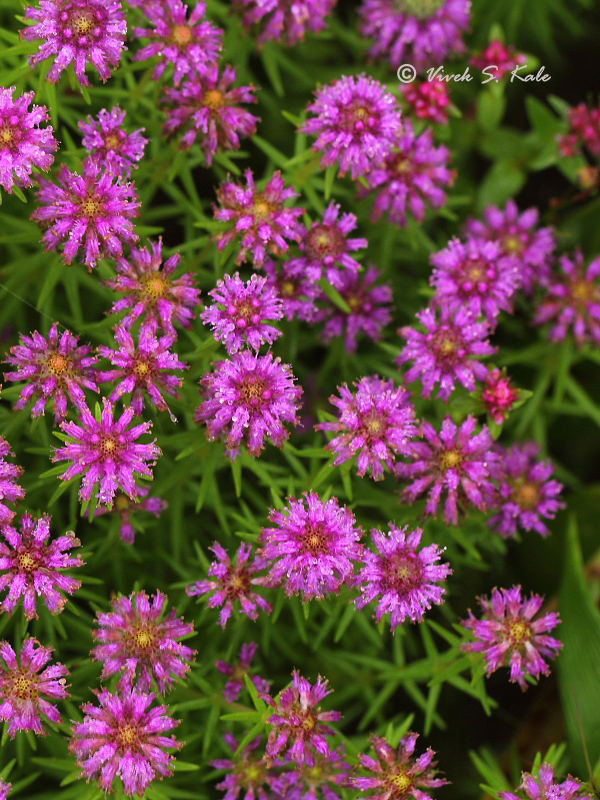
|
| |
| 10. Pogostemon deccanensis bloom, Ahmednagar district, Maharashtra, Western ghats, India |
| |
|
|
जांभळी मंजिरी नावाने ओळखली जाणारी वनस्पती पावसाळ्यात घाटमाथ्यावर सह्याद्रीत दिसते. पाण्याच्या लहान डबक्यात खुप संख्येने एकत्र उगवते. या वनस्पतीला हिरवे तुरे असतात. या तुऱ्यांवर जांभळी लहान फुले येतात. या फुलांचा एकत्र ताटवा आल्हाद दायक असतो. शास्त्रीय भाषेत या वनस्पतीला पोगोस्टेमोन डेक्कनेन्सिस असे म्हणतात. जांभळ्या मंजिरीच्या पुर्ण तुऱ्यावर फुले एकदम येत नाहीत. तुऱ्याच्या खालच्या भागात फुले प्रथम येतात. खालची फुले वाळल्यानंतर वरची फुले येतात.
|
|
Pogostemon decannensis is a small aquatic herb seen in small shallow water puddles. These plants are gregarious and its flowers bloom in large numbers. The flowers are purple in colour. The plant attracts the pollinators due to its scent. These plants can be seen in small puddles on basalt plateaus, giving a feel of a flower pots in post monsoon season. These plants are called as Jambhali Manjiri in Marathi. The interesting aspect of these flowers is that there are many tiny flowers on the main flower head. These tiny flowers do not bloom on the head all at a time. As can be seen in the photograph, the flowers bloom from bottom to top. The bottom flowers are dried up in this photograph. The flowers are in the middle of the head, and yet to appear on the top of the head.
|
|
|
| |
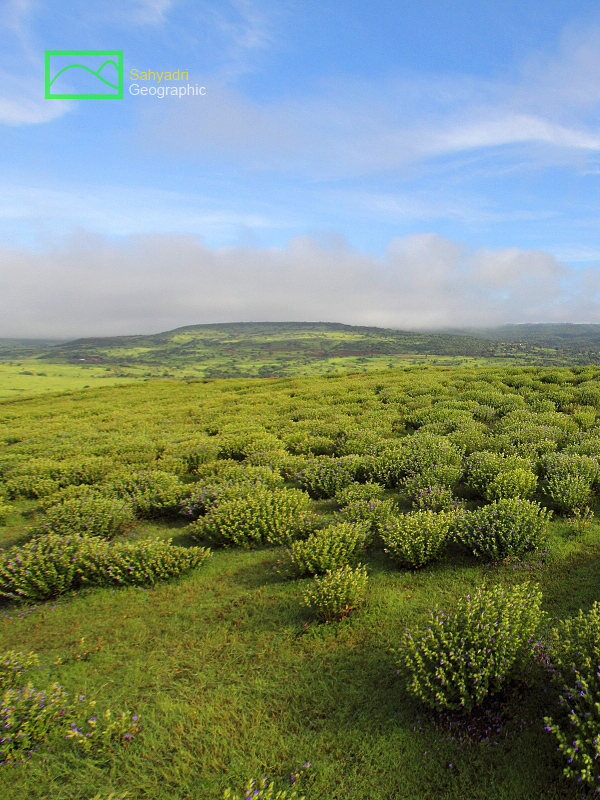 
|
| |
| 11. Pleocualus ritchei, Satara district, Maharashtra, Western ghats, India |
| |
|
|
टोपली कारवी च्या टोपल्या आपल्याला सह्याद्रीच्या घाटमाथ्यावर डोंगर उतारावर व सपाटीवर आढळतात. या वनस्पतीस प्लिओकौलस रिची असे म्हणतात. या वनस्पतीला ७-८ वर्षानंतर फुले येतात. या प्रकारे काही वर्षानंतर अश्या प्रकारे फुले येण्यास "मास्ट सिडिंग" असे म्हणतात. असे का अस्सवे याचे बरेच शास्त्रीय तर्क आहेत. फुलांवर मधमाश्या व लहान गवत पक्षी मध व पराग गोळा करताना दिसतात. यामुळे वनस्पतीस परागीकरण होण्यास मदत होते.
|
|
Pleocaulus ritchie is called as Topli karvi in Marathi. The plant is shaped semispherical and is low on the ground. The plant blossoms once in seven to eight years, Such flowering phenomenon is called as Mast seeding. The intermittent production of large seed crops by population of plants is called as Mast seeding. This phenomenon is seen in some long lived plants which are less affected by the cost of not reproducing in some years. The plants are pollinated by various grassbirds, honey bees and insects. These plants are often seen on the edge of the Deccan plateau at higher altitudes, both on basalt as well as lateritic plateaus.
|
|
|
| |
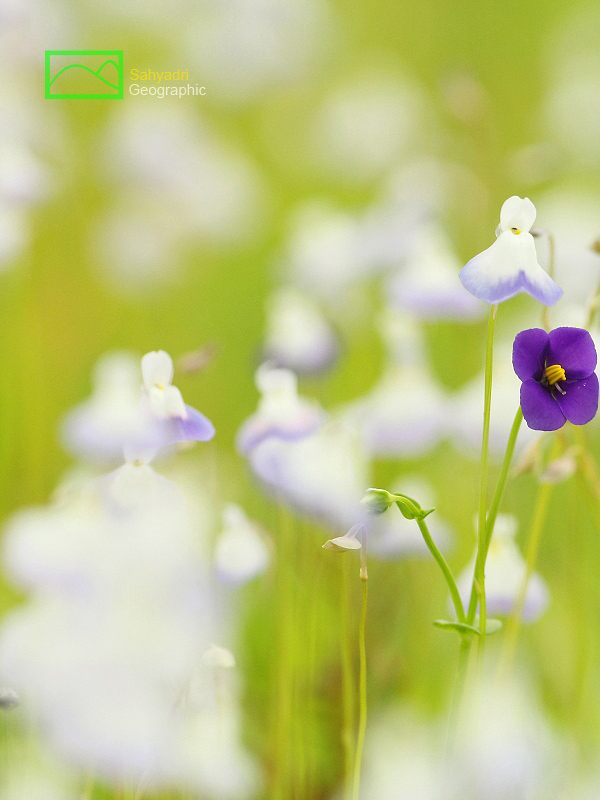 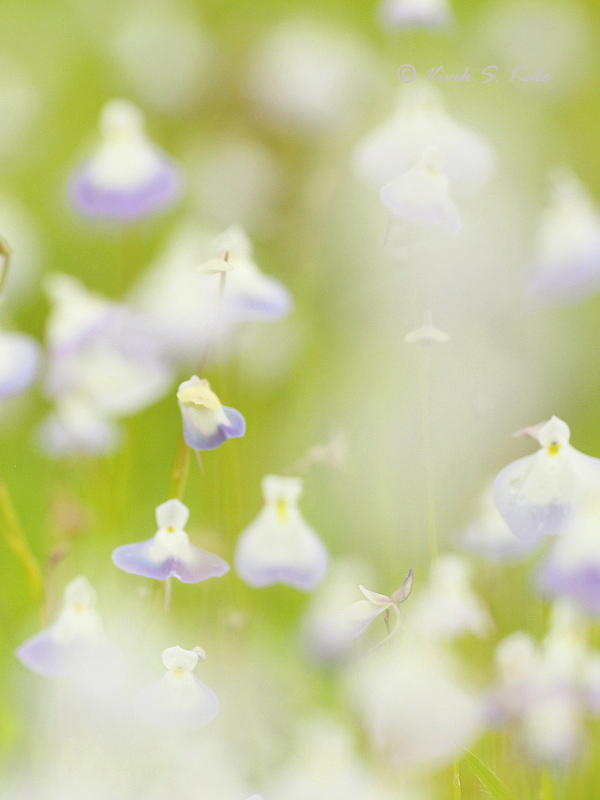
|
| |
| 12. Exacum lawii surrounded by utricularia species, Sindhudurg district, Maharashtra, Western ghats, India |
| |
|
|
एक्झॅकम लावी एक लहान वनस्पती असुन आपल्याला पावसाळ्यात हि वनस्पती सह्याद्रीत दिसते. सड़्याच्या अथवा बेसाल्टच्या पठारांवर हि वनस्पती दिसते. फुले अत्यंत लहान असतात. त्यांचा जांभळा रंग उठावदार असतो. त्याला चार पाकळ्या असतात. त्याला लहान चिरायत असे म्हणतात.
युट्रिक्युलेरिआ जातीच्या वनस्पती किटकभक्षी वनस्पती आपला सह्याद्रीत आढळतात. या वनस्पती अत्यंत लहान असतात. पावसाळ्यात पाणथळ ठिकाणी या वनस्पती उगवतात. या वनस्पतींना टोकावर फुल येते. वनस्पतीला पाने नसतात. जमिनीखाली मात्र या वनस्पतीच्या मुळांचे जाळे असते. या जाळ्यात लहान लहान फुग्यांसारख्या पिशव्या असतात. या पिशव्यांना एक लहान तोंड असते व त्याला एक झाकण असते. झाकणाबाहेर तंतु असतात. पिशव्यांना बाहेरुन सुक्ष्म जीवांना आकर्षित करता येईल असे आवरण असते. तंतु चा हालचालीमुळे झाकण उघडते. बाहेरचे पाणी सुक्ष्म जीवांसकट पिशवीच्या आत जाते. झाकण क्षणभरात बंद होते. पिशवीच्या आत असलेल्या पाचक द्रव्यांमुळे सुक्ष्म जीव विरघळतात व वनस्पतीला खाद्य मिळते. या दरम्यान पिशवीच्या आवरणातुन आतले पाणी हळु हळु बाहेर पाझरते. हि प्रक्रिया ओसमोसिस मुळे होते. पिशवी रिकामी झाल्यावर पुन्हा झाकण उघडले जाते. पुन्हा बाहेरचे पाणी जीवांसकट आत घेतेले जाते. अशी प्रक्रिया सतत घडते राहाते. पावसाळ्याअखेर वनस्पतीच्या बिया आजुबाजुस पसरतात. वनस्पती वाळुन जाते. पुढच्या पावसाळ्य़ात पुन्हा उगवते. असे निसर्ग चक्र चालु रहाते. सर्व किटक भक्ष वनस्पतींमध्ये युट्रिक्युलेरिआची जीव पकडण्याची पद्धत सर्वात जास्त गुंतागुंतीची व प्रभावी आहे. शास्त्रीय भाषेत या वनस्पतीला युट्रेक्युलेरिआ असे म्हणतात.
.. |
|
Exacum lawii is a small herb seen on the lateritic or basalt plateaus in western ghats. The flowers are seen in August and September. The plant is very tiny with violet colored tiny flowers which have four petals. Utricularia plants are commonly called as bladderwort plants.The important part of any bladderwort plant is beneath the surface of soil. The prominent flowering stem can be seen above the ground. This plant has long branching network of stems beneath the surface. The small bladder traps and leaves are attached to these stems. The word utricularia is derived from latin word utriculus. It means a small wine bottle. This small bag or a bladder has a opening which is sealed. The bladder has external secrations to attract the small organisms. The bladder or a small bag has tiny hair like structures, which act as a trigger to open the seals of the bladder. If the trigger is actuated, the small bladders are filled with water as the seals of the bladder are opened. With the water small organisms such as protozoa enter the bladder. This is a process which happenes in a split second. Once inside the prey is dissolved due to digestive enzymes secreted by the plant. The water is slowly pumped out of the bladder, creating the vacuum inside. Inspite of vacuum the bladder does not collapse. The water is pumped out by osmosis process, through the thin membranes of the bladder. Once the pumping stops due to osmosis, the seals open. As the seals open, the water enters inside due to the vacuum generated. This process continues in cycles. It is said that these plants have the most sofisticated trapping mechanism amongst all the carnivorous plants.
|
|
|
| |
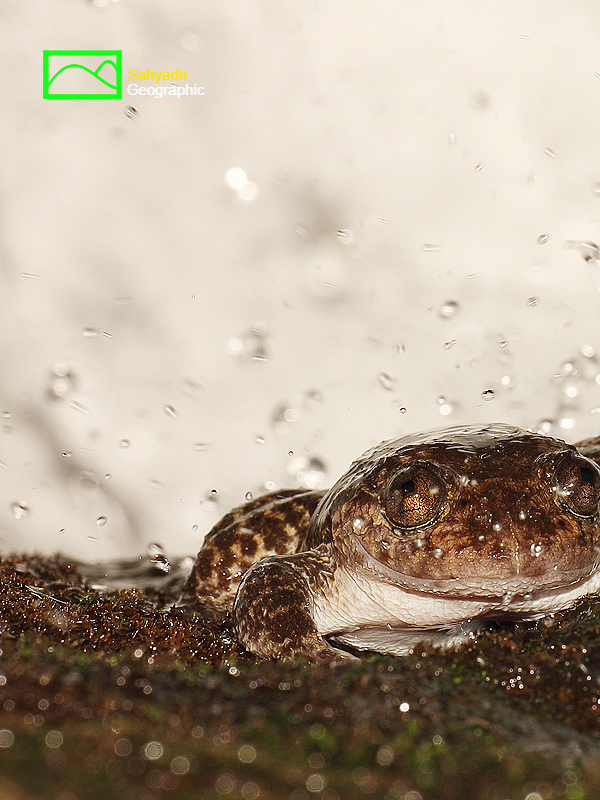 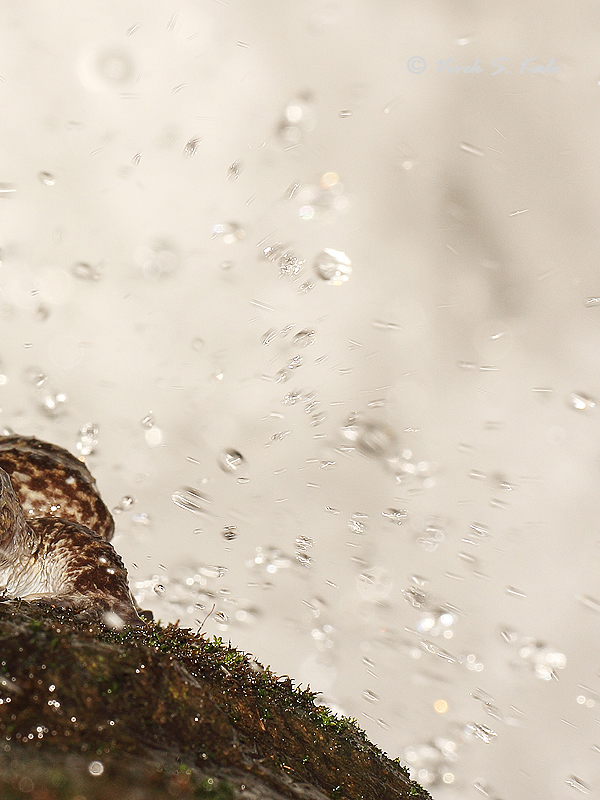
|
| |
| 13. Nyctibatrachus grandis, Kodagu district, Karnataka, Western ghats, India |
| |
|
|
पश्चिम घाटामध्ये, कर्नाटकाच्या कोडगु जिल्ह्यात, कुर्ग भागात, बेडकांचे विविध लघु अधिवास आहेत. गवताळ डोंगर, सदाहरित जंगल, शोला जंगल, लहान झुडपे, पाणथळ डबकी, झरे, माणसाने लावलेली कॉफी ची लागवड असे अनेक लहान मोठे अधिवास असल्याने येथे बेडकांच्या विविध जाती आढळतात. या बेडकांमध्ये निक्टिबॅट्रचस जातीचे पाण्यांच्या प्रवाहाजवळ दगडावर रहाणारे बेडुक सुद्धा आहेत. सतत होणाऱ्या जंगलतोडी मुळे या फ्रॉग्स ची संख्या कमी होत आहे. जंगलतोड करुन विस्तारली गेलेली शेती व अनियंत्रित पर्यटन त्यांच्या ऱ्हासाची प्रमुख कारणे आहेत.
या विविध फ्रॉग्स मध्ये निक्टिबॅट्रचस ग्रॅन्डिस नावाचा एक मोठया आकाराचा बेडुक आहे. हा बेडुक मध्यम पानगळीच्या किंवा सदाहरित दमट जंगलात, पाण्याच्या ओढ्यांलगत आढळतो. हा बेडुक निशाचर आहे. याला वायनाड निशाचर बेडुक असे म्हणतात. त्याचे प्रजनन जंगलात ओढ्यांजवळ होते. त्याच्या अंगावर सुरकुत्या असतात. त्याच्या डोळ्यांमधले बुबुळ चौकोनी असते. हा बेडुक सह्याद्रीत अंतर्जन्य (एन्डेमिक) आहे.
|
|
The western ghats in Coorg region in Karnataka state have wide array of microhabitats for the frogs. The streams, water puddles and moist shola forest are few of these arrays of microhabitats. Both grasslands and shola forests in western ghats have seasonal water streams during the monsoon season. Nyctibatrachus frogs are seen around the water streams. These are nocturnal species mainly active in the night.
One of the Nyctibatrachus frogs of the region is Nyctibatrachus grandis, commonly known as Wayanad night frog. Nyctibatrachus grandis is recorded in torrential freshwater streams in evergreen and moist deciduous forest. Breeding takes place in streams in the forest. It is not seen in degraded forests.
It is endemic to western ghat, and is rated as not evaluated as per IUCN red list.
The frog is gray in color with black markings and wrinkled texture. The front leg and hind leg digits have discs which help the frog to climb the rocks.
|
|
|
| |
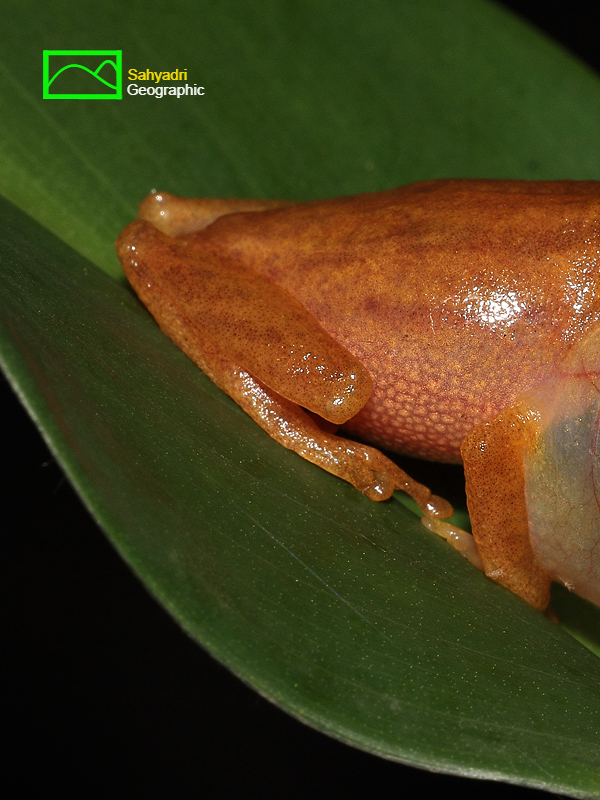 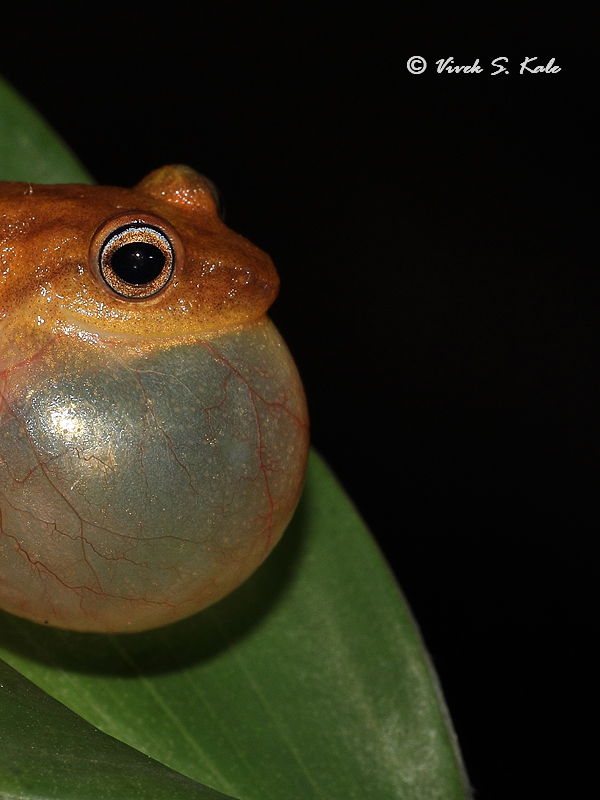
|
| |
| 14. Raorchestes lutelous, Kodagu district, Karnataka, Western ghats, India |
| |
|
|
पश्चिम घाटामध्ये, कर्नाटकाच्या कोडगु जिल्ह्यात, कुर्ग भागात, बेडकांचे विविध लघु अधिवास आहेत. गवताळ डोंगर, सदाहरित जंगल, शोला जंगल, लहान झुडपे, पाणथळ डबकी, झरे, माणसाने लावलेली कॉफी ची लागवड असे अनेक लहान मोठे अधिवास असल्याने येथे बेडकांच्या विविध जाती आढळतात. या बेडकांमध्ये बुश फ्रॉग (राओर्चेस्टेस) म्हणजे झुडुपांमध्ये व लहान झाडांवर रहाणारे बेडुक सुद्धा आहेत. राओर्चेस्टेस प्रकारचे ५२ बेडुक आपल्या देशात आढळतात. सतत होणाऱ्या जंगलतोडी मुळे या बुश फ्रॉग्स ची संख्या कमी होत आहे. जंगलतोड करुन विस्तारली गेलेली शेती व अनियंत्रित पर्यटन त्यांच्या ऱ्हासाची प्रमुख कारणे आहेत.
या विविध बुश फ्रॉग्स मध्ये राओर्चेस्टेस लुटेलॉस नावाचा एक मध्यम आकाराचा बेडुक आहे. याला निळ्या डोळ्यांचा पिवळा बुश फ्रॉग असे म्हणतात. याचा आकार ३०-३४ मी.मी असतो. नर आकाराने लहान असतो. मादी तुलनेने आकारात मोठी असते. हा बेडुक मध्यम पानगळीच्या किंवा सदाहरित जंगलात व त्याच्या आजुबाजुस आढळतो. त्याचे वास्तव्य लहान झुडुपांमध्ये जमिनीपासुन १ ते ४ मीटर उंचीपर्यंत असते. या बेडकांच्या अंड़्यांमधुन बेडकाचा जन्म होतो. यात टॅड्पोल अवस्था नसते. कर्नाटक (दक्षिण) राज्यात सह्याद्रीत समुद्रसपाटीपासुन ९०० ते ११०० मीटर उंचीवर असलेल्या जंगलात तो आढळतो.
आय यु सि एन संस्थेच्या वर्गीकरणात या बेडकास "डाटा डिफिशियंट" असा वर्ग देण्यात आला आहे. या बेडकांचा अजुन खुप अभ्यास होणे अपेक्षित आहे. या बेडकाचे वैशिष्ट्य म्हणजे तो झाडावर रहातो. त्याच्या पुढच्या व मागच्या पायांना बोटांच्या टोकांना लहान तबकड़्या असतात. या तबकड़्यांचा वापर बेडुक झाडांवर चढण्यास करतो. त्याच्या मागच्या पायांच्या बोटांमध्ये क्वचित प्रसंगी पोहोण्यासाठी अगदी लहान पडदे असतात. नराला मानेजवळ एक फुगा असतो. सुर्यास्तानंतर तो फुगा फुगवुन मादीला आकर्षित करण्याचा प्रयत्न करताना दिसतो.
या बेडकाचे तोंड निमुळते असते. डोळ्यांचा रंग पिवळट सोनेरी असुन त्याभोवती निळे वर्तुळ असते. डोळ्यांमधले बुबुळ काळे असते. हा बेडुक रंगाने तपकिरी पिवळा असतो. त्याच्या अंगावर अस्पष्ट तपकिरी पट्टे असतात. पोटाकडे पिवळ्या रंगावर तपकिरी जाळीदार नक्षी असते.
हा बेडुक हा बेडुक ट्र्र्र्र्र्र्र्र टक टक टक टक टक टक टक असा आवाज काढतो.
हा बेडुक पश्चिम घाटात अंतर्जन्य (एन्डेमिक) आहे. सह्याद्री बाहेर इतरत्र हा बेडुक आढळत नाही.
|
|
The western ghat in Coorg region in Karnataka have wide array of microhabitats for the frogs. The small bush habitat of coffee plantation is one of these arrays of microhabitats. Though coffee plantation is completely man made habitat, there is also, the natural forest habitat around most of these coffee plantations. There are about 52 species of bush frogs from Raorchestes family in India. This frog genus is under grave threats, mainly due to the habitat degradation caused by the cultivation of eucalyptus, coffee and tea plantations. The deforestation, agricultural practices and unplanned tourism are the other threats to this family of frogs. One of the bush frogs of the region is Raorchestes luteolus, commonly known as Yellow bush frog or blue eyed bush frog. It is about 30-34 mm in size. This frog is seen in evergreen shrubs and lower levels of forest trees in moist semideciduous forests. It is endemic to western ghats, and is rated as data defficient as per IUCN red list. The frog is seen mainly in south western ghats north of Palakkad gap. This species has been recorded at Madenadu and near Madikeri in Kodagu District, Karnataka. It has also been recorded from Malleshwaram in Kudrumukh in Chikmagalur District. All these records are from the Western Ghats of the southern part of Karnataka State, India. The altitudinal range of this species is 920-1120 meter above sea level. The frog is yellow in color with light brown specks uniformly granular in texture and usually has four to six faint discontinuous stripes running from snout to vent in dorsal region. Iris in the eye of this frog is golden yellow with blue outer ring. The frog has pointed snout. The flank and belly of the frog is deep granular. The front leg and hing leg digits have discs which help the frog to climb the bushes and small rocks. The front legs do not have any webs. The hind legs have very small webbing between the digits. Males are yellow during breeding season and cream in the non-breeding season. Males have a median vocal sac. This species begins calling during or immediately after sunset.
|
|
|
| |
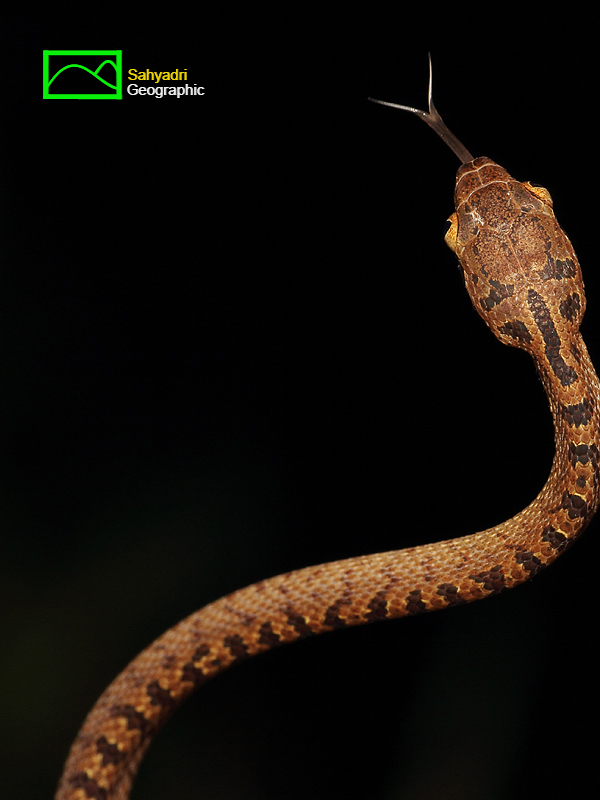 
|
| |
| 15. Bedomme cat snake, Kodagu district, Karnataka, Western ghats, India |
| |
|
|
| |
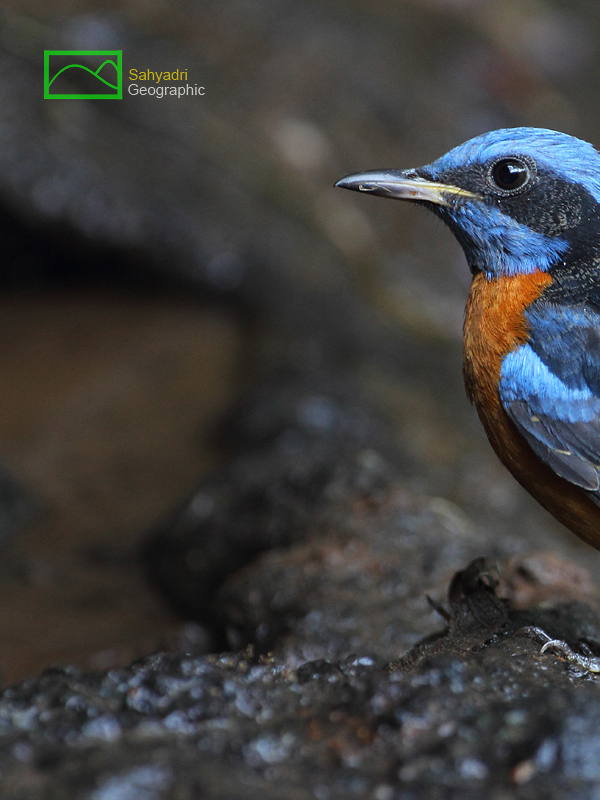 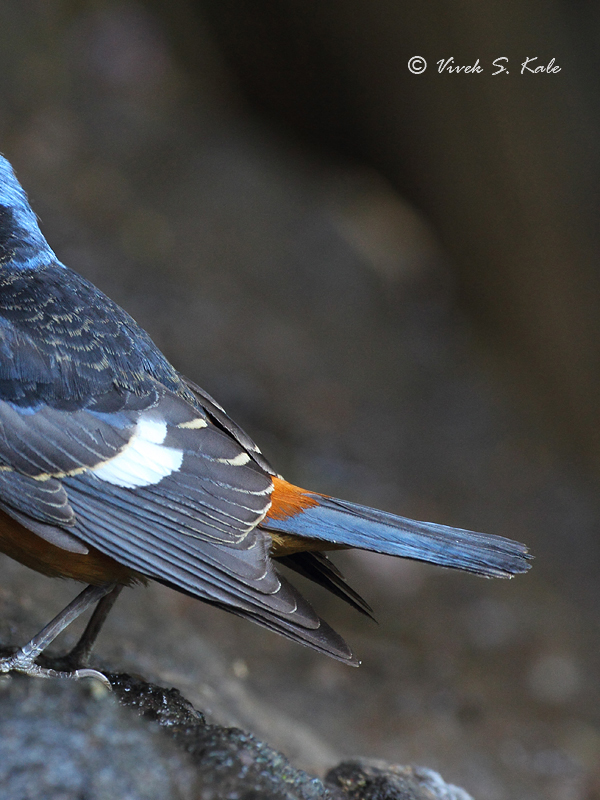
|
| |
| 16. Blue capped rock thrush male, Satara district, Maharashtra, Western ghats, India |
| |
|
|
ब्लु कॅप्ड रॉक थ्रश हा लहान हिमालयन पक्षी, हिवाळ्यात सह्याद्रीच्या व पुर्व भारतातील जंगलांमध्ये स्थलांतर करुन येतो. हा पक्षी रंगाने केशरी व निळा असतो. याचा आकार बुलबुल पक्ष्याएवढा असतो.
या पक्ष्याला मराठीत प्रचलित नाव नसले तरी आपण त्याला निळ्या टोपीचा कस्तुर असे म्हणु शकतो. हा पक्षी अंदाजे १७ से. मी. आकाराचा असतो. नर आणी मादी पक्षी रंगरुपाने वेगवेगळे दिसतात. अश्या प्रकारास इंग्रजीत सेक्शुअल डाउमोर्फिजम असे म्हणतात.
नर पक्षी रंगाने निळा आणी केशरी असतो. त्याचा माथा, गळा व मान निळ्या रंगाची असते. त्याच्या पाठीकडचा भाग आणी पोटाकडचा भाग केशरी असतो. त्याच्या पिसांचा भाग निळा, केशरी, सफेद आणी काळा असतो. त्याचे डोळे तपकिरी असतात. पाय पांढरट करडे असतात. त्याची शेपुट निळी असते. त्याची चोच काळी असुन त्याचा काही भाग पिवळट असतो
मादी पक्षी रंगाने ओलिव्ह करडा असतो. तीच्या पोटावर गडद तपकिरी करड़्या खुणा असतात. तीच्या पाठीकडे व माथ्यावर गडद तपकिरी करड़्या खुणा असतात. अगदी लहान पिल्ले सुद्धा मादीसारखी दिसतात.
निळ्या टोपीचा कस्तुर हिवाळ्यात सह्याद्रीच्या जंगलात आढळतो. तसेच तो मध्य व पुर्व घाटातील जंगलात सुद्ध आढळतो.मे ते सप्टेंबर या उन्हाळयाच्या काळात तो हिमालयाच्या पायथ्याच्या डोंगराळ भागात (१ ते ३ हजार मीटर उंचीवर) विणीसाठी रहातो. त्यांचे घरटे जमिनीवर झाडांखाली, दगडांच्या खपचीत करतात. हिवाळ्यात हा पक्षी शांत असतो, तो फारसा आवाज करत नाही. विणी च्या हंगामात मात्र तो त्याची शीळ वाजवतो.
|
|
Scientific name of Blue-capped rock thrush is Monticola cinclorhynchus. It is also called as blue headed rock thrush. This is a small Himalayan thrush bird. It has cobalt blue and orange plumage. Its size is close to that of bulbul.
The bird is about 17 cm in size (length from its beak to tail). The sexual dimorphism can be seen in this bird species. Sexual dimorphism is the difference in appearance between males and females of the same species, such as in colour, shape, size, and structure.
The male bird has cobalt blue crown, chin, nape and throat. The upper parts are cobalt blue and black. rump, upper tail-coverts, whole lower surface, axillaries and under wing-coverts are orange.Lesser wing coverts are bright cobalt blue. The upper tail coverts are orange in color. Lores, cheeks, ear-coverts, sides of neck, back and scapulars are black in color. The greater wing-coverts are black edged with blue.
The primaries are black, all except the first two edged with blue. The secondaries are black, all except the innermost with a broad white band on the base of the outer webs . This white patch on the wing that is visible during flight. The tail is blackish edged narrowly with blue .Iris is dark brown. The gape is yellow and In the non-breeding season the base o£ the lower mandible is also yellowish.
The female bird is olive brown. The female has olive brown upperparts which are barred with dark brown and whitish underparts which are scaledamd barred with brown.The female has buff baring on uppertail coverts Juvenile birds resemble female. Male juvenile bird has white wing bars.
There is are no further subspecies of blue capped rock thrush, Monticola cinclorhynchus. This bird breeds in the foothills of the Himalayas (1000 meter to 3000 meter altitude). In winter it is found in Pakistan, some parts of Myanmar and India. In India the bird is seen in winter in western ghat, Assam hills and central east forests from October to April.
These birds nest on the ground in tree root crevice or in the rock crevice. These birds are mainly arboreal. They feed on insects in bark and on branches. They also sometimes forage among leaves in the forest floor.
|
|
|
| |
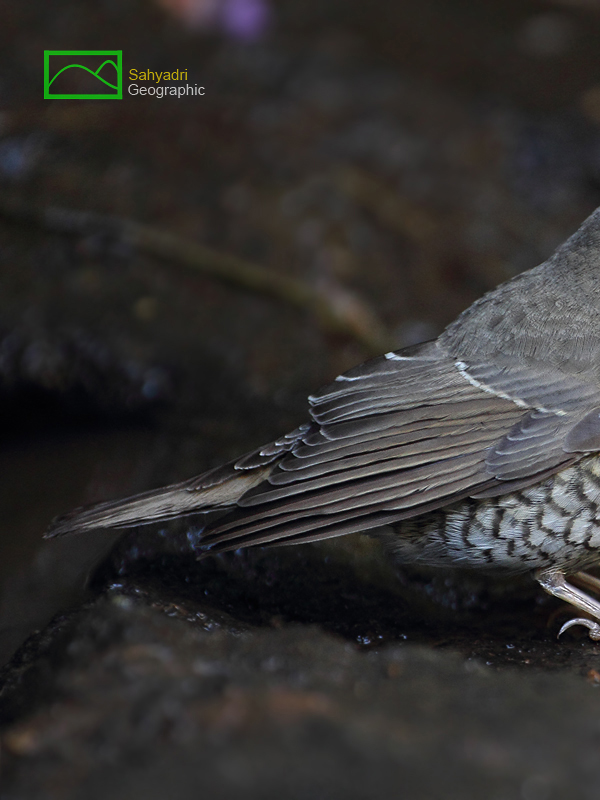 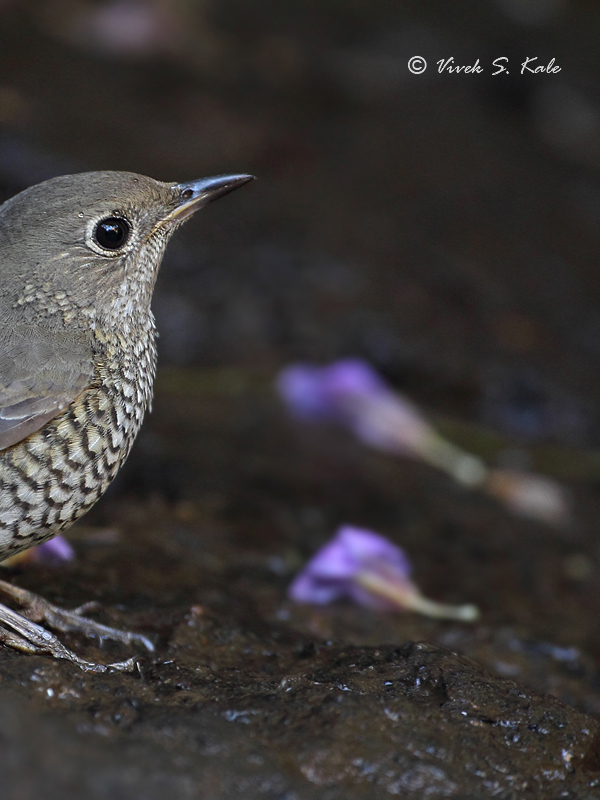
|
| |
| 17. Blue capped rock thrush female, Satara district, Maharashtra, Western ghats, India |
| |
|
|
| |
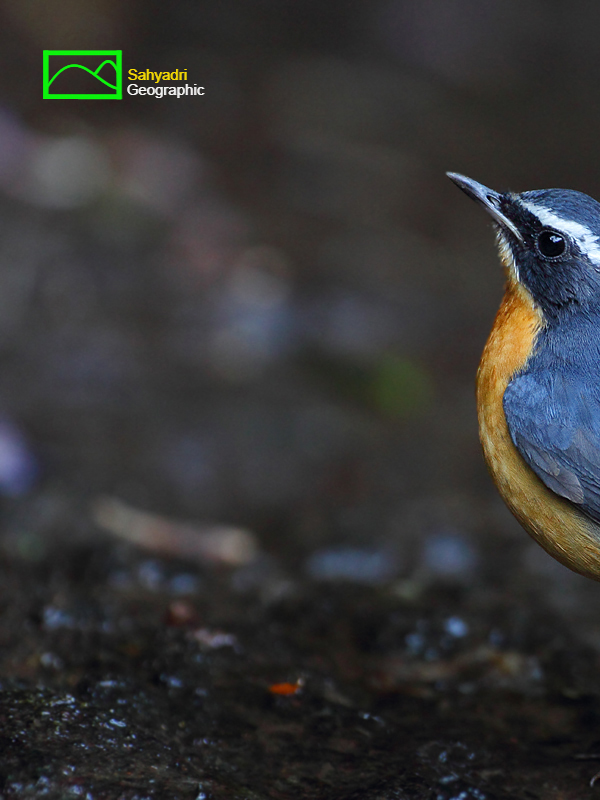 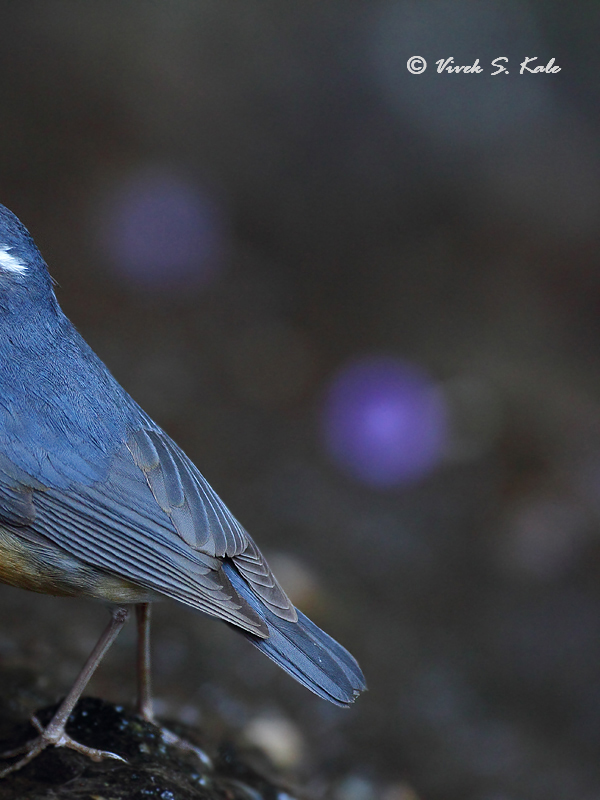
|
| |
| 18. Indian blue robin, Satara district, Maharashtra, Western ghats, India |
| |
|
|
इंडियन ब्लु रॉबिन हा एक लहान चिमणी पेक्षा थोडा मोठा पक्षी आहे. हा पक्षी हिमालयात व ब्रह्मदेश, चीन मध्ये विणीच्या हंगामात आढळतो. जंगलात जमिनीवर झाडांखालच्या पानगळीत हा पक्षी रहातो. पाठीकडे निळा तर पोटाकडे केशरी रंगाचा हा पक्षी दिसायला अत्यंत सुंदर दिसतो. मराठीत याला सर्वमान्य नाव नसले तरी आपण याला निळा चीरक असे म्हणु शकतो.
निळा चीरक आकाराने १३ ते १५ से.मी. लांब असतो. नर व मादी पक्षी रंगरुपाने वेगवेगळे दिसतात. याला इंग्रजीत सेक्शुअल डायमोर्फिजम असे म्हणतात. नर पक्षी रंगरुपाने अत्यंत सुंदर असतो. नर पाठीकडे काळपट निळा असतो. तर छाती कडे तो केशरी रंगाचा असतो. त्याच्या डोळ्यावर सफेद आडवी भुवईसारखी लांब व रुंद पट्टी असते. इतरत्र डोळ्याच्या आजुबाजुसचा रंग काळपट निळा असतो. शेपटाखालचा भाग सफेद असतो. हनवटीला व काळ्या गालांखाली लहान सफेद लकेर असते. त्याचे पाय पांढरट गुलाबी असतात.
मादी पक्ष्याचा रंग हिरवट करडा भुरा असतो. पोटाकडे तीचा रंग सफेद असतो. पक्ष्याची पिल्ले एक दिड वर्षांपर्यंत मादी सारखी दिसतात. त्यांचे रंग जास्त गडद असतात.
निळ्या चीरकाच्या दोन उपजाती आहेत. लुसिनिया ब्रुनिआ ब्रुनिआ आणी लुसिनिया ब्रुनिआ वीकहॅमी अशी त्यांची नावे आहेत. यातील लुसिनिया ब्रुनिआ ब्रुनिआ उपजातीचे पक्षी उन्हाळ्यात विणीसाठी उत्तर अफगाणीस्तान पासुन पुर्वोत्तर भारतातील हिमालयात, मध्य चीन मध्ये आढळतात. हिवाळ्यात लुसिनिया ब्रुनिआ ब्रुनिआ उपजातीचे पक्षी भारत व श्रीलंका च्या जंगलात आढळतात. लुसिनिया ब्रुनिआ वीकहॅमी उपजातीचे पक्षी मात्र स्थलांतर करत नाहीत. हे पक्षी मणिपुर व ब्रह्मदेशाच्या चीन प्रांतातील डोंगररांगामंध्ये आढळतात.
निळा चीरक किडे खातो. घनदाट जंगलात जमिनीवर पडलेल्या पालापाचोळ्यात हा पक्षी चालता चालता किडे पकडताना दिसतो. झाडांवर तो क्वचित जातो. असे चरताना तो क्वचित प्रसंगी उड़्या मारतो. शेपटाच्या पिसांचा फुलोरा करुन त्या हालचाली करतो. जमिनीवर पडलेली पाने उलटवुन तो त्या खालच्या किड़्यांना शोधतो. झऱ्यांच्या आजुबाजुस पाणथळ भागात तो हमखास आढळतो. मे ते जुलै या काळात तो हिमालयात व चीनमध्ये विणीसाठी जातो. तेथे तो जमिनीवर आपले घरटे बनवतो. हिवाळ्यात सह्याद्री, श्रीलंका, पुर्व घाटात जंगलात आढळतो. त्याची शीळ तो सुरवातीस संथ हळुहळु वाजवतो तर शेवटाला तो शीळ वाजवण्याची गती वाढवतो.
|
|
Scientific name of Indian blue robin is Luscinia brunnea. The bird is also known as Indian blue chat. This is a small Himalayan bird from thrush family (Turdidae). It has blue and orange plumage. It is slightly larger than the common house sparrow. The bird seems to have no name in Marathi.
The bird is about 13 to 15 cm in size (length from its beak to tail). The sexual dimorphism can be seen in this bird species. Sexual dimorphism is the difference in appearance between males and females of the same species, such as in colour, shape, size, and structure.
The male bird has blue upperparts. The underbody of male bird is orange rufous. The bird has long broad white supercilium. The lore of the male bird is bluish black. The eye strip is blusih black which coverts ear coverts up to neck. Point of chin and narrow line under the black cheeks is white. The under tail and lower belly are white. The legs and feet are pale pinkish white. Iris of the eyes is dark brown.
The adult female is olive-brown with whitish under-parts except for the Rufus breast. The young male is like the female but has the back darker and much suffused with blue.
There are two subspecies of Indian blue robin, Luscinia brunnea. The two subspecies are Larvivora brunnea brunnea and Larvivora brunnea wickhami. Out of these 2 subspecies, Larvivora brunnea brunnea is prominently recorded in India. Larvivora brunnea brunnea breeds in north east Afghanistan east through Himalaya to north eastern India and central china. The bird migrates in winter to India and Srilanka. The other subspecies Larvivora brunnea wickhami is recorded in Chin hills of Myanmar and is not migratory.
The Indian blue robin is insectivorous bird. These birds are found in dense evergreen forest undergrowth. It feeds mainly on the ground. It moves around in undergrowth in forested region.It uses its tail fanning for these small hops and manoeuvres on the ground. It turns the leaves on the forest floor to search the insects, particularly around the moist streams and under the trees with fruits fallen on the ground. It breeds from May to July in Himalaya. It nests on the ground. The female is believed to incubate but both sexes take part Indian blue robin sings and calla in their winter grounds. The song consists of sudden and sharp series of whistles ending in a rapid series of notes. They also utter a sharp and low clicking alarm note.
|
|
|
| |
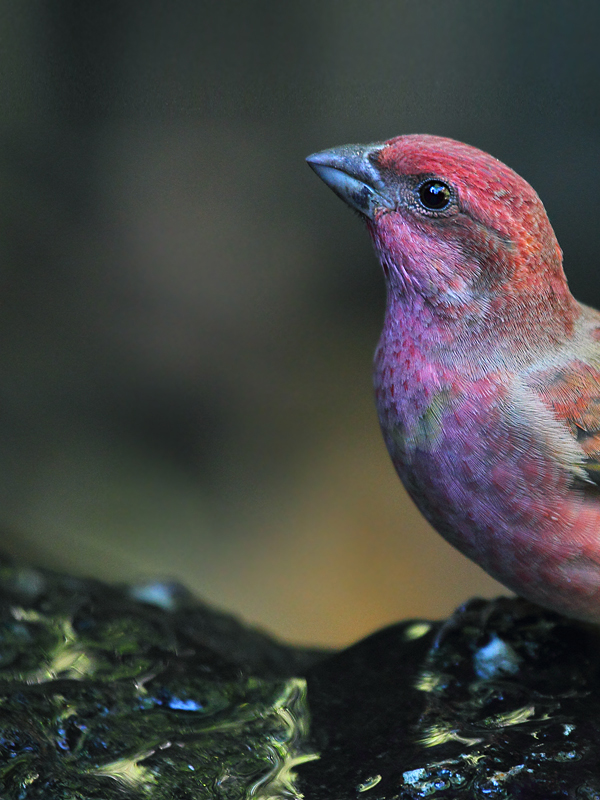 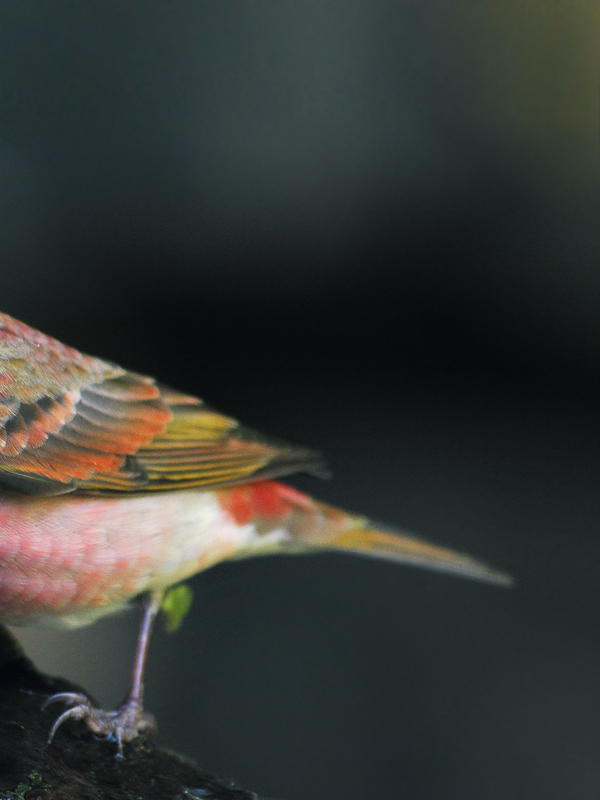
|
| |
| 19. Common rosefinch, Satara district, Maharashtra, Western ghats, India |
| |
|
|
कॉमन रोजफिंच हा एक चिमणीपेक्षा थोडा मोठा पक्षी आहे. याला मराठीत सर्वमान्य नाव नाही. आपण याला गुलाबी चिमणी असे संबोधु शकतो. या जातीचा नर पक्षी रंगाने लाल गुलाबासारखा असतो. म्हणुन या पक्ष्याला रोजफिंच असे म्हणतात. शास्त्रीय भाषेत याला कार्पोडेकस एरिथ्रिनस असे म्हणतात. रोजफिंच कुळात १५ जातीचे पक्षी भारतात आढळतात. यातले बहुसंख्य पक्षी हिमालयात आढळतात. कॉमन रोजफिंच किंवा गुलाबी चिमणी उन्हाळ्यात विणीच्या हंगामात हिमालय, युरोप, सैबेरिया, मध्य आशिया मध्ये आढळतो. तर हिवाळ्यात हा पक्षी भारतात पठारी भागात आढळतो.
गुलाबी चिमणी अंदाजे १४ ते १५ से.मी. आकाराची असते. हा आकार म्हणजे पक्ष्याच्या चोची पासुन शेपटाच्या टोकापर्यंत्चे अंतर होय. या पक्ष्याची चोच चिमणीसारखी आखुड पण जाड शंखुसारखी असते. या आकारामुळे पक्ष्याला गवताच्या व इतर लहान बिया खाणे सोपे होते. या पक्ष्याच्या नर व मादीमध्ये रंगरुपात मोठा फरक असतो. अश्या फरकाला सेक्शुअल डायमोरफिजम असे म्हणतात.
नर पक्षी रंगाने गुलाबी लाल असतो. त्याचे डोके, छाती व पाठ गुलाबी असते. पक्ष्याचा पाठीकडच्या भागाला गुलाबी छटा असते. पोटाकडे पांढरट करड़्या रंगावर गुलाबी रेघा असतात. या पक्ष्याच्या पाच उपजाती आहेत. या उपजातींमध्ये रंग छटा थोड़्या वेगवेगळ्या असतात. नर पक्ष्याच्या डोळ्याभोवतीचा रंग थोडा तपकिरी असतो. त्याचे डोळे तपकिरी असतात. त्याचे पाय गुलाबी तपकिरी असतात.
मादी पक्षी रंगाने हिरवट करड़्या रंगाचा असतो. मादीच्या डोक्यावर, पोटाकडे हिरव्या रेघा असतात. पाच पोटजातींच्या मादींमध्ये फार लहान फरक आहे. नर व मादी पक्ष्यांची शेपटी दोन टोकाची असते. या पक्ष्याची पिल्ले एक दिड वर्षाची असे पर्यंत मादी सारखी दिसतात. त्यांच्या पोटावरच्या रेघा गडद असतात.
या पक्ष्याच्या ५ उपजाती आहेत. एरिथ्रिनस, ग्रेबिनिट्स्की, कुबानेन्सिस, फरघानेन्सिस व रोजेअटिस अशी या पाच उपजातींची नावे आहेत. यातील चार उपजाती भारतात आढळतात. एरिथ्रिनस, कुबानेन्सिस, फरघानेन्सिस व रोजेअटिस या चार उपजाती भारतात आढळतात.
एरिथ्रिनस उपजातीचे पक्षी विणीसाठी उत्तर व पूर्व युरोप, पश्चिम सैबेरिया, युक्रेन, मंगोलिया मध्ये जातात. हिवाळ्यात ते भारत, थायलंड ला स्थलांतर करतात. कुबानेन्सिस उपजातीचे पक्षी विणीसाठी तुर्कस्तान, कोकेशियस, इराण, तुर्कमेनिस्तान येथे जातात. हिवाळ्यात ते भारतात स्थलांतर करतात. फरघानेन्सिस उपजातीचे पक्षी विणीसाठी कझाकस्तान, किरगिझस्तान, पश्चिम चीन, अफगाणीस्तान, वायव्य हिमालय येथे जातात. हिवाळ्यात ते वायव्य भारतात स्थलांतर करतात. रोजेअटिस उपजातीचे पक्षी विणीसाठी मध्य व ईशान्य हिमालय, तिबेट, ब्रह्मदेश येथे जातात. हिवाळ्यात ते वायव्य रत, बह्मदेश, थायलंड, लाओस, व्हिएतनाम आणी आग्नेय चीन मध्ये स्थलांतर करतात.
या पक्ष्याच्या ५ उपजाती आहेत. एरिथ्रिनस, ग्रेबिनिट्स्की, कुबानेन्सिस, फरघानेन्सिस व रोजेअटिस अशी या पाच उपजातींची नावे आहेत. यातील चार उपजाती भारतात आढळतात. एरिथ्रिनस, कुबानेन्सिस, फरघानेन्सिस व रोजेअटिस या चार उपजाती भारतात आढळतात.
एरिथ्रिनस उपजातीचे पक्षी विणीसाठी उत्तर व पूर्व युरोप, पश्चिम सैबेरिया, युक्रेन, मंगोलिया मध्ये जातात. हिवाळ्यात ते भारत, थायलंड ला स्थलांतर करतात. कुबानेन्सिस उपजातीचे पक्षी विणीसाठी तुर्कस्तान, कोकेशियस, इराण, तुर्कमेनिस्तान येथे जातात. हिवाळ्यात ते भारतात स्थलांतर करतात. फरघानेन्सिस उपजातीचे पक्षी विणीसाठी कझाकस्तान, किरगिझस्तान, पश्चिम चीन, अफगाणीस्तान, वायव्य हिमालय येथे जातात. हिवाळ्यात ते वायव्य भारतात स्थलांतर करतात. रोजेअटिस उपजातीचे पक्षी विणीसाठी मध्य व ईशान्य हिमालय, तिबेट, ब्रह्मदेश येथे जातात. हिवाळ्यात ते वायव्य रत, बह्मदेश, थायलंड, लाओस, व्हिएतनाम आणी आग्नेय चीन मध्ये स्थलांतर करतात.
गुलाबी चिमणी हिवाळ्यात मध्य व दक्षिण भारतात आढळते. युरोप, सैबेरिया, मध्या आशिया मधुन आलेल्या चार उपजातींचे पक्ष्यांचे थवे भारतात हिवाळ्यात पसरतात. हे पक्षी गवातचे बी, फुलांमधले मध, पराग, व लहान फळे खातात. मे ते सप्टेंबर या काळात ते उत्तरेकडे विणी साठी जातात. हे पक्षी लहान झाडांवर गवतापासुन घरटे बनवतात.
|
|
Scientific name of common rosefinch is Carpodacuserythrinus. This is a small Himalayan bird from finch family which has red plumage just like the red rose. It is slightly larger than the common house sparrow. The bird seems to have no name in Marathi. Out of about 15 rosefinch species, common rosefinch is one of the most prominent and common rosefinch species is India.
The bird is about 14 to 15 cm in size (length from its beak to tail). The bird has short stocky conical beak. The beak is silvery grey. The shape of the beak is suitable for eating the seeds. The sexual dimorphism can be seen in this bird species. Sexual dimorphism is the difference in appearance between males and females of the same species, such as in colour, shape, size, and structure.
The male bird has red head, red breast and red rump. The upperparts are streaked with red wash. The underbody is also streaked in red extended on flanks and under belly. The erythrinus subspecies has less red wash on its upperparts and underbelly. However in case of roseatus subspecies, the upperparts and underbelly is extensively red as compared to the erythrinus subspecies. The erythrinus species has brown mantle with white underpants with red streaks restricted to breast on underpants. The lore of the male bird is brown. The legs and feet are dusky brown. Iris of the eyes is dark brown.
The female bird is olive grey in color. It has streaks on whitish underpants. It has buff median-covert wing bars. It has whitish greater-covert bars. The streaks seen in female erythrinus subspecies are faint as compared to roseatus subspecies. Both male and female have forked tail. So overall the erythrinus subspecies male and female are paler as compared to that seen in roseatus and ferghanensis subspecies. The juvenile birds are similar to female birds with prominent streaking.
There are five subspecies of common rosefinch, Carpodacus erythrinus. The five subspecies are Carpodacus erythrinus erythrinus ,Carpodacus erythrinus grebnitskii , Carpodacus erythrinus kubanensis , Carpodacus erythrinus ferghanensis and Carpodacus erythrinus roseatus. Out of these 5 subspecies, four subspecies are recorded in India. The subspecies seen in India are Carpodacuse rythrinus erythrinus ,Carpodacus erythrinus ferghanensis, Carpodacus erythrinus kubanensis and Carpodacus erythrinus roseatus.
Carpodacus erythrinus erythrinus breeds North and east Europe, West Siberia North west Mongolia and Croatia, Romania, Ukraine, Kazakhstan in summer. It migrates to the plains of Indian subcontinent and north west Thailand in winter. Carpodacus erythrinus kubanensis breeds in Turkey, Caucasus, north Iran and Turkmenistan in summer and migrates to the plains of Indian subcontinent in winter. Carpodacus erythrinus ferghanensis breeds in mountains of Kazakhstan, Kyrgyzstan, West China, Afghanistan, North West Himalayas east to Kashmir) in summer and migrates to north west India in winter. Carpodacus erythrinus roseatus breeds in central and east Himalayas from Ladakh to North East India, North Myanmar, Tibetan plateau. It winters in India, Myanmar, Thailand, Laos,Vietnam and South east China.
The birds are seen in flocks in winter during the migration. The birds feed on nectar, small fruits and seeds. The bird breeds in summer from June to September. It builds its nest in bush using grass.
|
|
|
| |
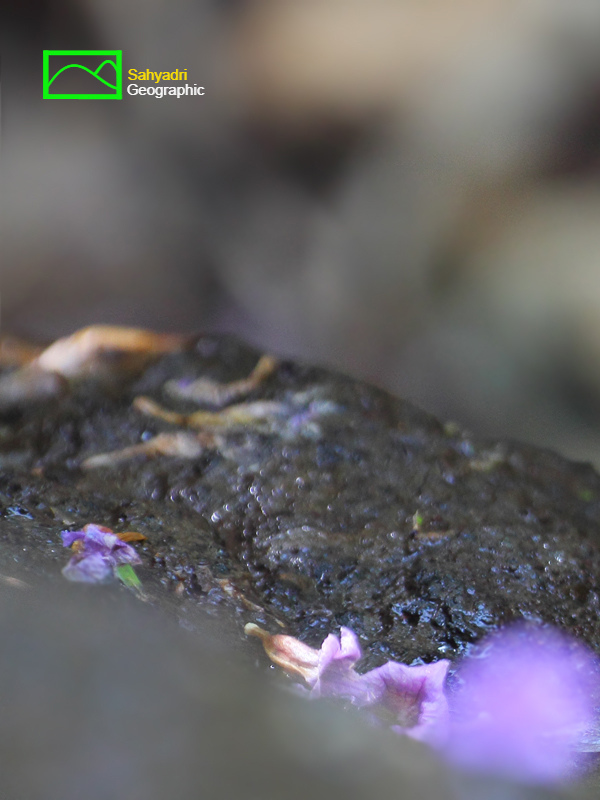 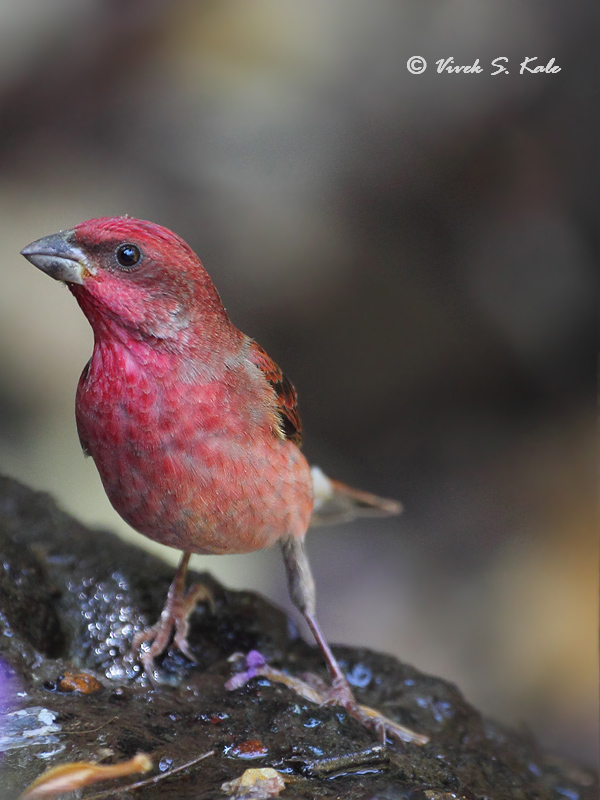
|
| |
| 20. Common rosefinch, Satara district, Maharashtra, Western ghats, India |
| |
|
|
| |
 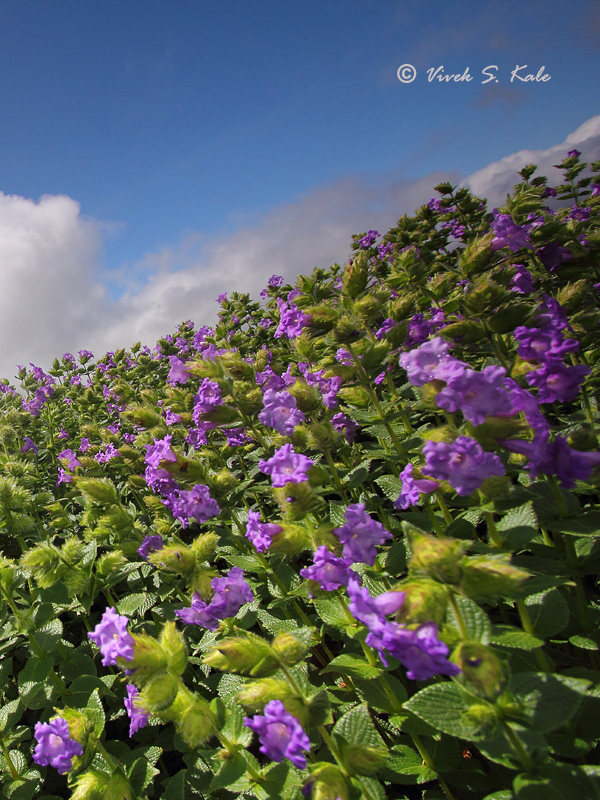
|
| |
| 22. Pleocualus ritchie species, Satara district, Maharashtra, Western ghats, India |
| |
|
|
टोपली कारवी च्या टोपल्या आपल्याला सह्याद्रीच्या घाटमाथ्यावर डोंगर उतारावर व सपाटीवर आढळतात. या वनस्पतीस प्लिओकौलस रिची असे म्हणतात. या वनस्पतीला ७-८ वर्षानंतर फुले येतात. या प्रकारे काही वर्षानंतर अश्या प्रकारे फुले येण्यास "मास्ट सिडिंग" असे म्हणतात. असे का अस्सवे याचे बरेच शास्त्रीय तर्क आहेत. फुलांवर मधमाश्या व लहान गवत पक्षी मध व पराग गोळा करताना दिसतात. यामुळे वनस्पतीस परागीकरण होण्यास मदत होते
|
|
Pleocaulus ritchie is called as Topli karvi in Marathi. The plant is shaped semispherical and is low on the ground. The plant blossoms once in seven to eight years, Such flowering phenomenon is called as Mast seeding. The intermittent production of large seed crops by population of plants is called as Mast seeding. This phenomenon is seen in some long lived plants which are less affected by the cost of not reproducing in some years. The plants are pollinated by various grassbirds, honey bees and insects. These plants are often seen on the edge of the Deccan plateau at higher altitudes, both on baslat as well as lateritic plateaus.
|
|
|
| |
 
|
| |
| 24. Fireflies , Pune district, Maharashtra, Western ghats, India |
| |
|
|
पावसाळ्याआधी होणारे
काजव्यांचे प्रकाशनृत्य म्हणजे निसर्गाची किमया आहे.
|
|
The breeding display of fireflies, during the premonsoon season in 2016, is captured here as timetrail.
|
|
|
| |
 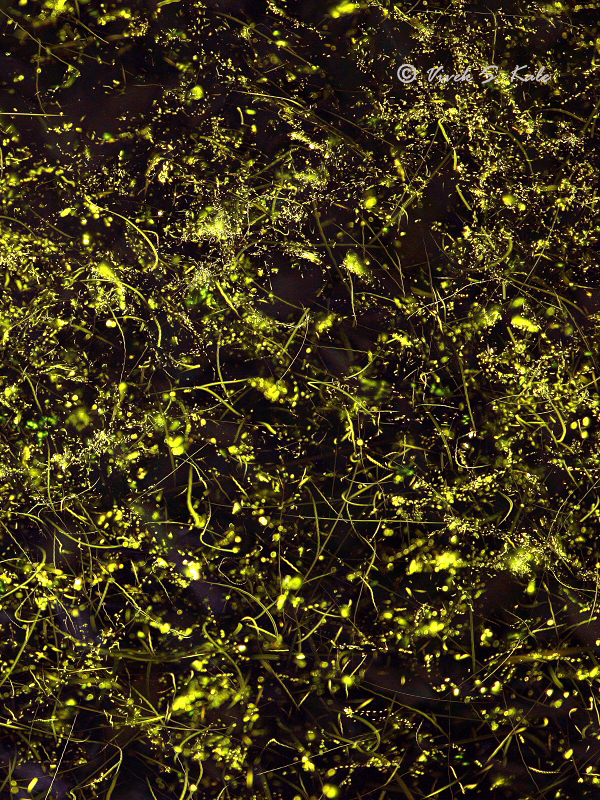
|
| |
| 25. Fireflies , Pune district, Maharashtra, Western ghats, India |
| |
|
|
| |
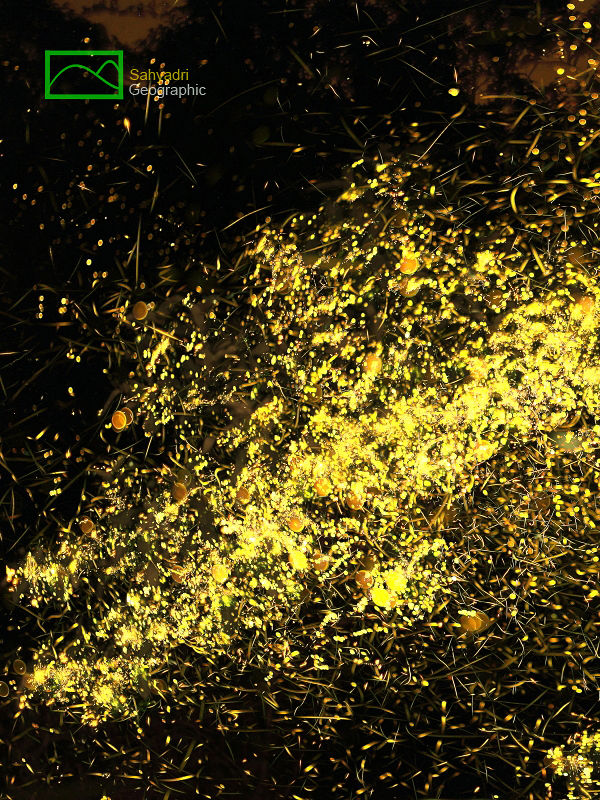 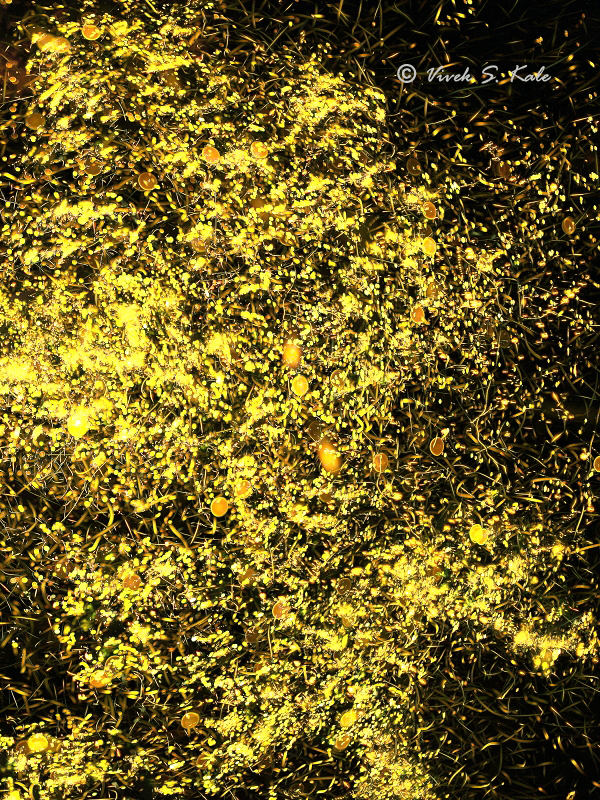
|
| |
| 26. Fireflies , Pune district, Maharashtra, Western ghats, India |
| |
|
|
| |
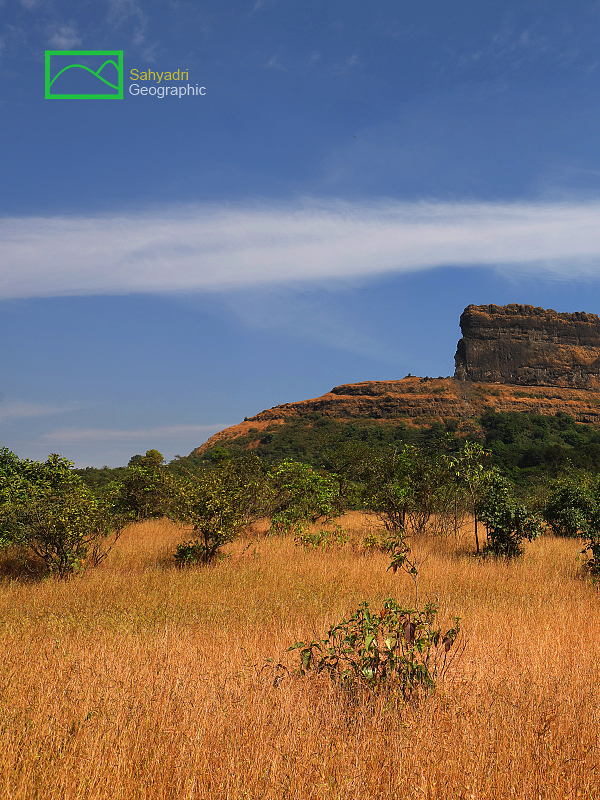 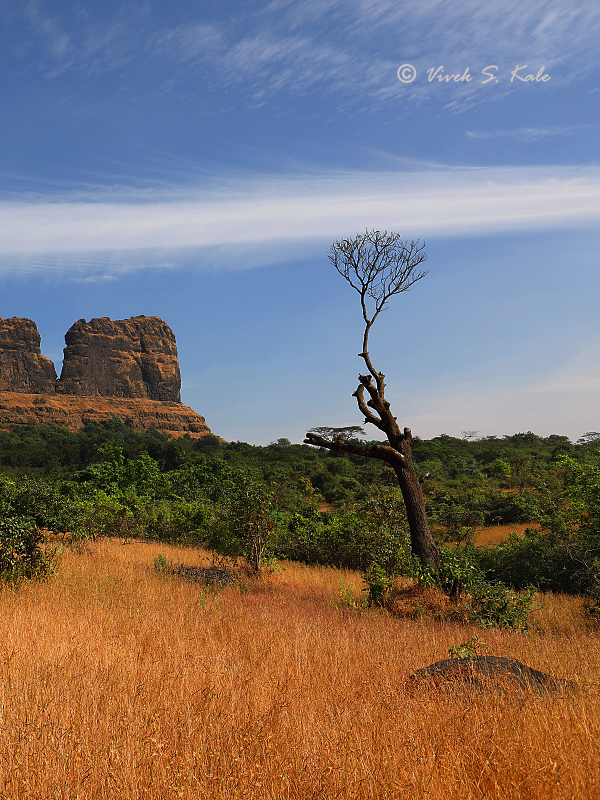
|
| |
| 27. Telbaila dyke, Pune district, Maharashtra, Western ghats, India |
| |
|
|
सुंदर सुर्यप्रकाशाने सांज वेळी, गवताने सजलेले रान सोनेरी झाले. वाऱ्याच्या हलक्या झुळुके संगत गवत झुलत होते. गवतावर लाटा वाहत होत्या. गवताच्या पात्यांची हलकी सळसळ ऐकु आली. सह्याद्रीच्या डोंगर माथ्यावर, नदयांच्या पात्रात, पठारांवरच्या माळरानी सर्वत्र गवत दिसते. पावसाळ्यात हिरवे तर इतर वेळी ते सोनेरी असते. शास्त्राप्रमाणे गवताने आपल्या गृहावर झालेल्या जीवसृष्टीच्या उत्पत्तीत, व माणसाच्या प्रगतीत मुख्य भुमिका पार पाडली आहे. माणसाने लावलेल्या शेतात, याच गवतावर गहु, भात पिकवला जातो. तर जंगलात निसर्गात गवताची पैदास पक्षी , प्राणी व किटक करतात. वाघाच्या पट्टेरी रुपाची प्रतिमा जणु वाऱ्याच्या झुळुकेसंग डोलणाऱ्या गवतात आहे. असे हे अप्रतिम गवत.
अनिरुद्ध धामोरीकर यांनी लिहिलेले हे गवताचे वर्णन स्वैर भाषांतर करुन मांडले आहे. त्याचे इग्रजी भाषेवरचे प्रभुत्व व निसर्गाबद्दल लिहिलेले लेख, "सह्याद्रीका" या त्यांच्या वेबसाईट ला भेट देऊन जरुर वाचा.
|
|
Annirudha Dhamorikar is one of the finest english writers I have seen when it comes to the articulation of thoughts and observations about nature and western ghats. Please read what he writes about the grass.
From the rolling plains to sharp precipices, and mountain tops to tumultuous rivers, grass is probably the only omnipresent entity, dancing to the music of its own rustling blades. Some scientists argue that grasses have shaped the evolution on our planet, and indeed have revolutionized our lives. Sahyadri’s rolling hills and table-top mountains are spread with a mosaic of lime-green paddies, the region’s staple food, and grasses untamed and wild, pollinated and, like humans, harvested by a number of animals. Indeed, it wouldn’t be wrong to say that the very tiger’s stripes are a reflection of the grass swaying in the wind.
- Annirudha Dhamorikar.
Please visit his website on Nature and Sahyadri
http://www.sahyadrica.com/
|
|
|
| |
 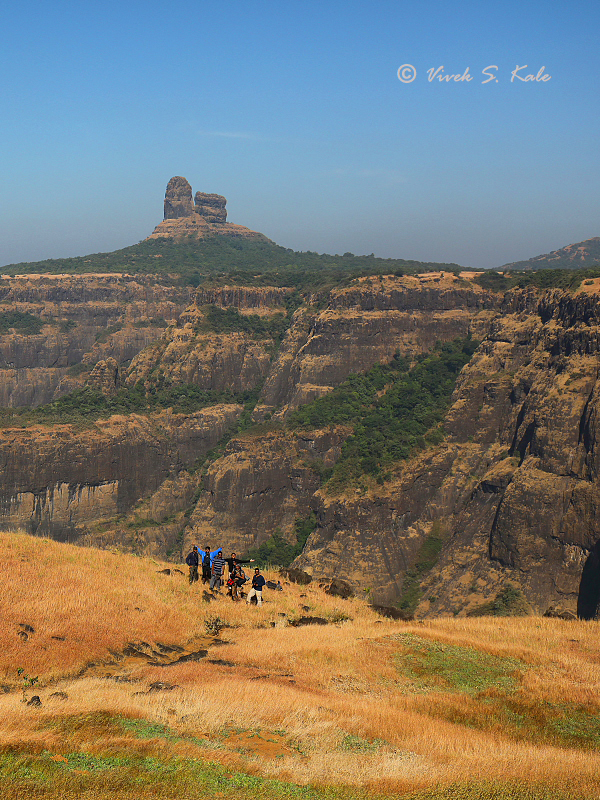
|
| |
| 28. Telbaila dyke, Pune district, Maharashtra, Western ghats, India |
| |
|
|
| |
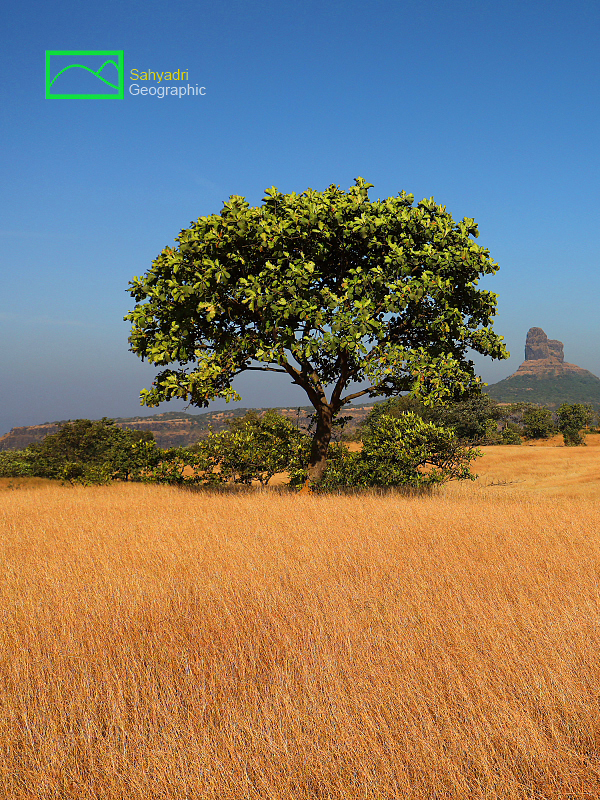 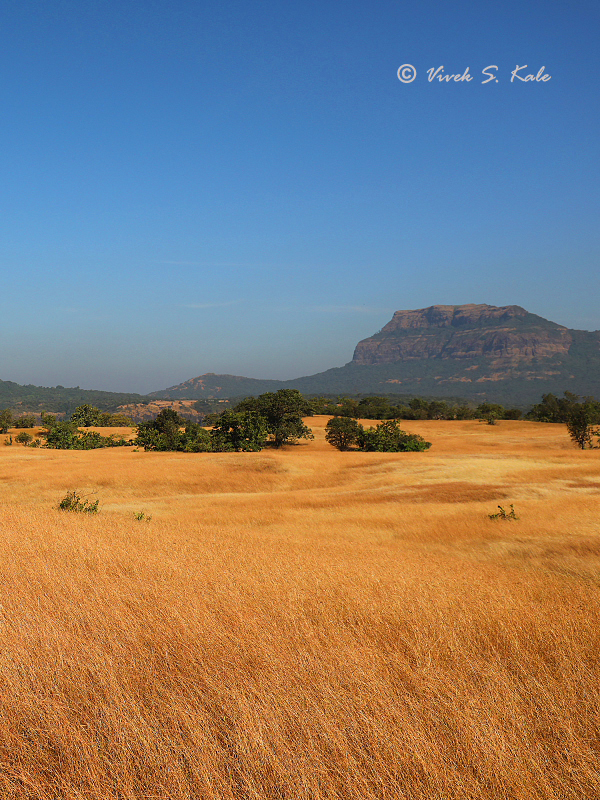
|
| |
| 29. Grassland and western ghat ridge, Pune district, Maharashtra, Western ghats, India |
| |
|
|
| |
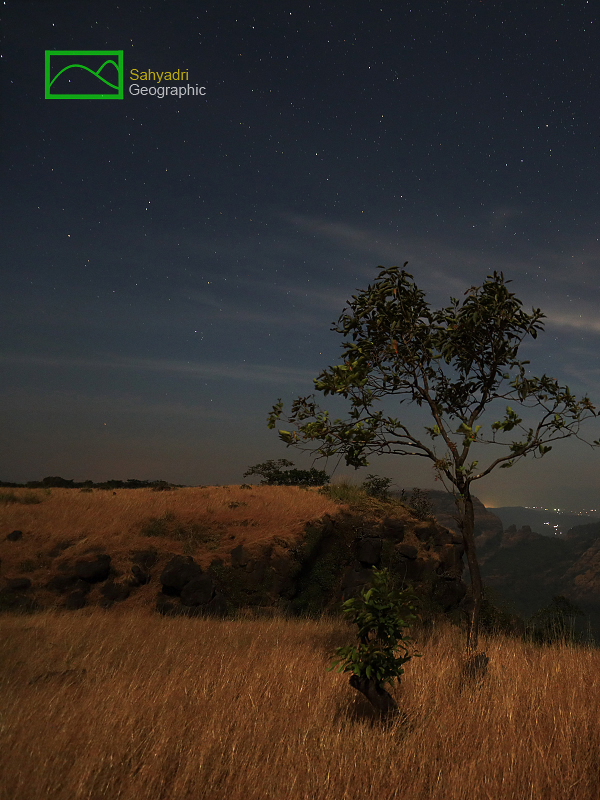 
|
| |
| 30. Grassland and western ghat ridge in moonlight, Pune district, Maharashtra, Western ghats, India |
| |
|
|
I want to know, have you ever seen the moon rise in the sky, with wind blowing at the middle of night.
I want to know, have you ever seen the mountain grass dance in moon light, with wind blowing at the middle of night.
I want to know, have you ever seen the millions of stars glitter in the sky, the mountain grass dance in moon light, with wind blowing at the middle of night.
Better you see before it is too late, before the grass dies, with wind yet blowing at the middle of night.
(inspired by eternal song "Have You Ever Seen the Rain?" by John Fogerty, 1971)
|
|
|
|
|
| |
 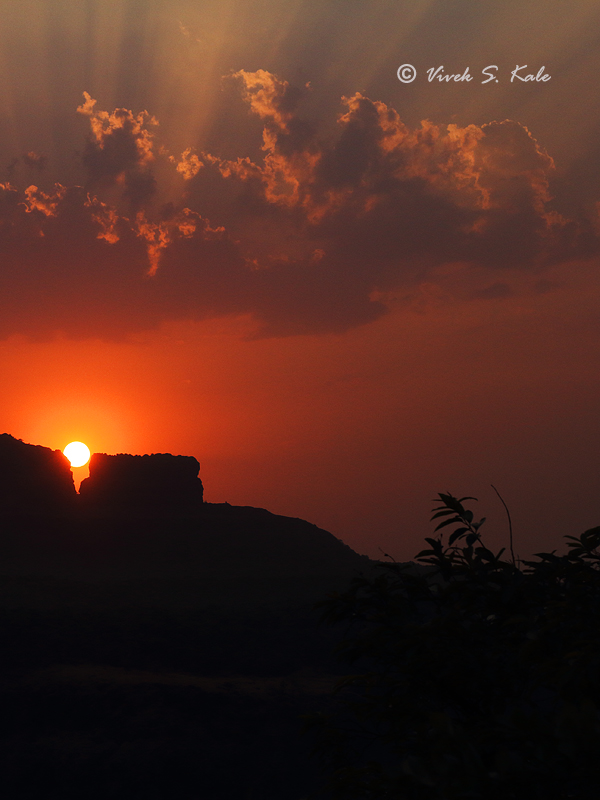
|
| |
| 31. Telbaila dyke, Pune district, Maharashtra, Western ghats, India |
| |
|
|
| |
|































































